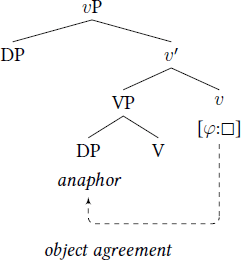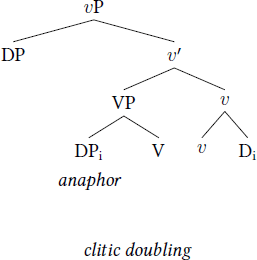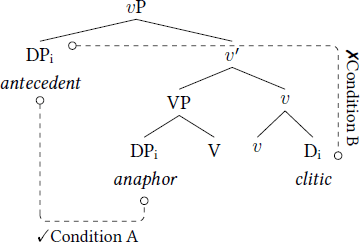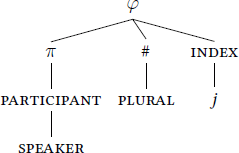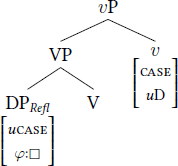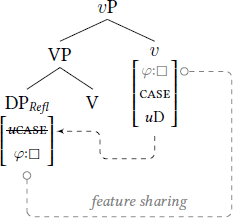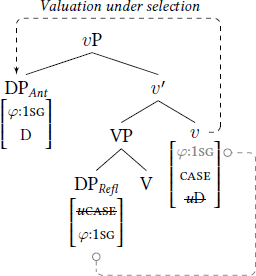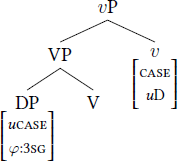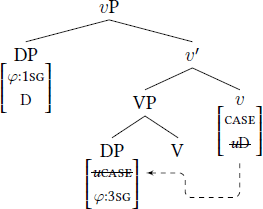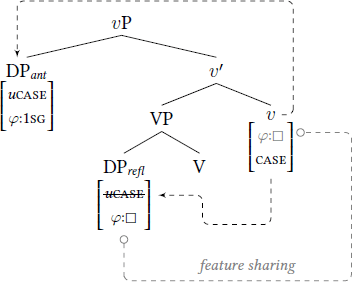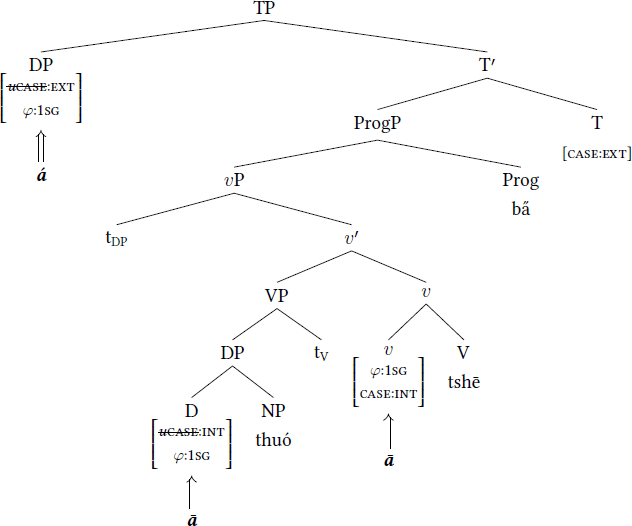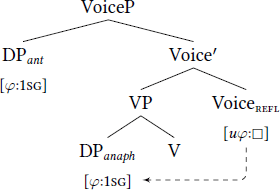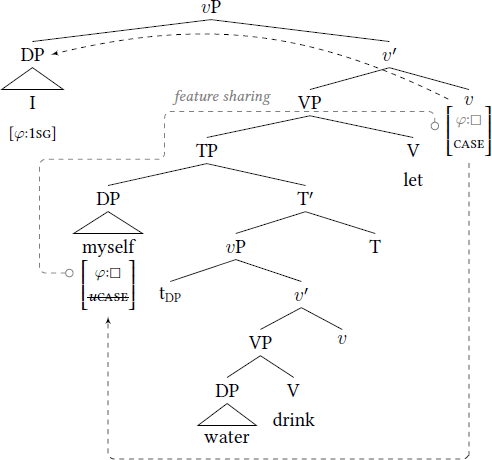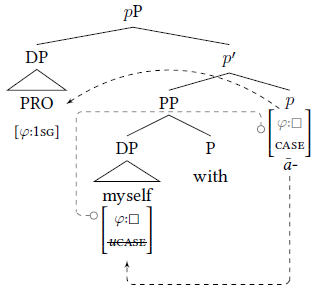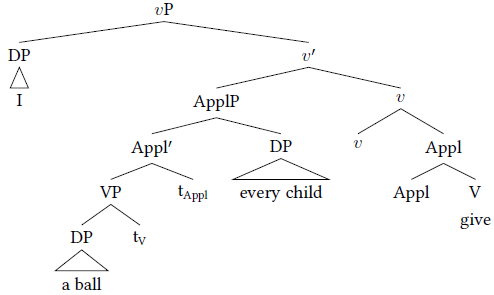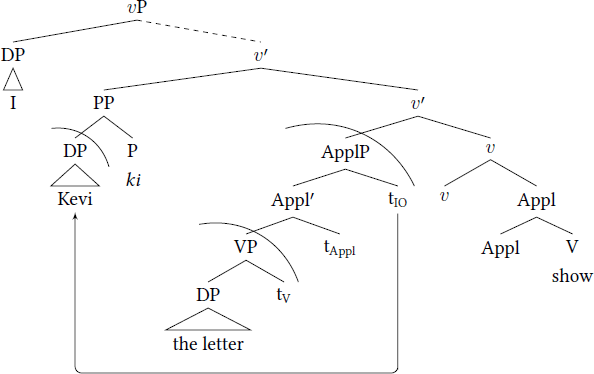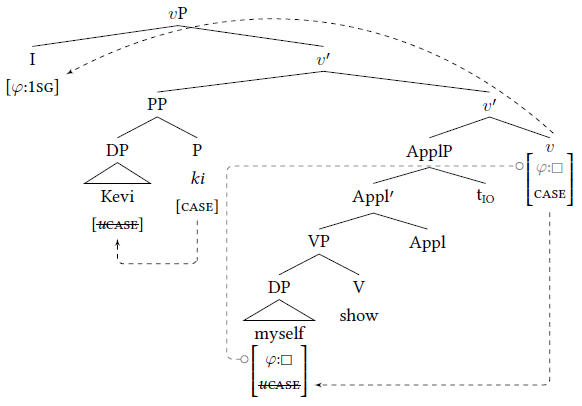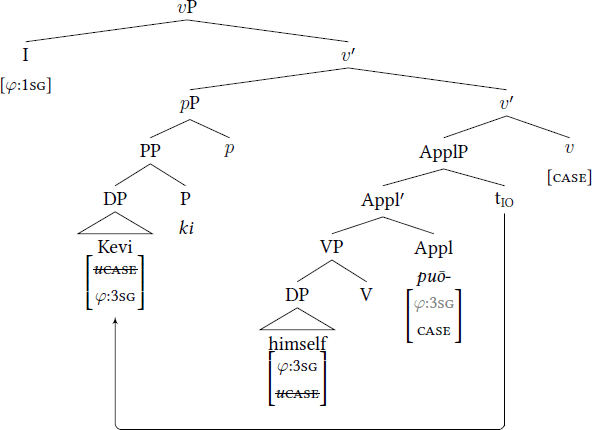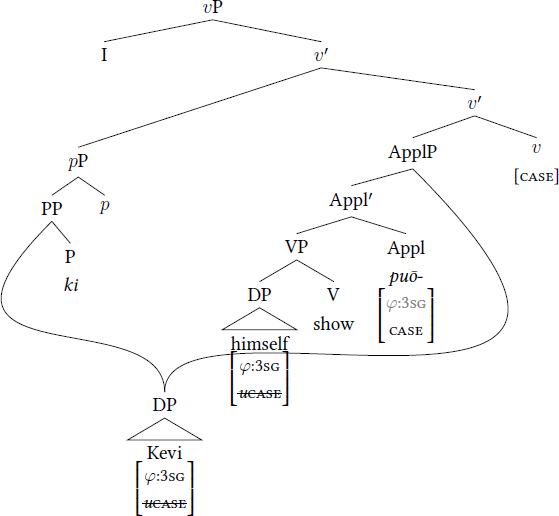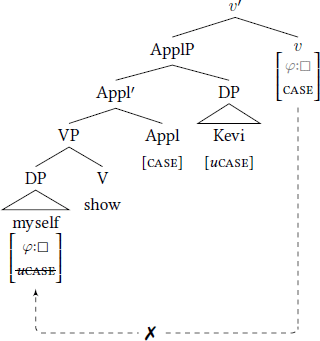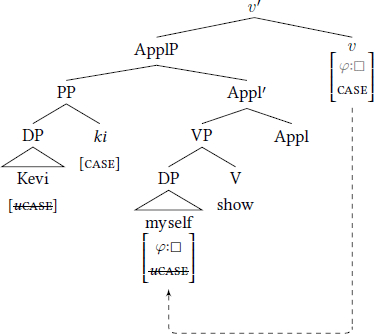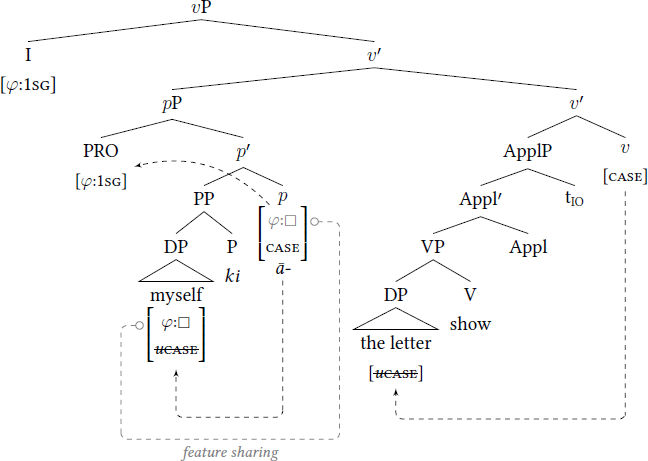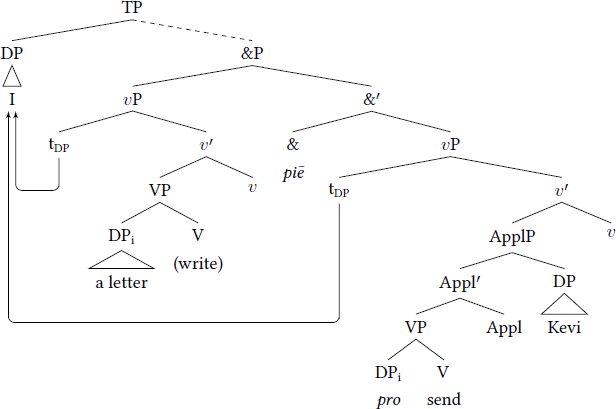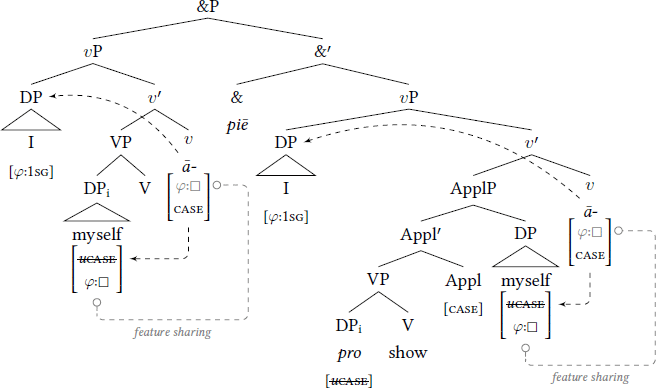1 Introduction
The precise nature of the relation between an anaphor and its antecedent has been a long-standing topic of interest in syntactic theory (e.g. Lees & Klima 1963; Chomsky 1965; 1973; 1981; Langacker 1969; Helke 1971; Jackendoff 1972; Wasow 1972; Reinhart 1976). The classic approach by Chomsky (1981) holds that it is determined by Condition A of Binding Theory (1).
- (1)
- Condition A:
- An anaphor must be bound in its local domain.
Condition A captures some of the basic distributional properties of typical anaphors in languages such as English. They require a c-commanding antecedent (2), this must typically be the most local antecedent (3),1 and the antecedent must also match the φ-features of the anaphor (4).
- (2)
- Anaphor must be bound by a c-commanding antecedent:
- [DP Bill’si father ]j looks after himself*i/j
- (3)
- Reflexive anaphor must be bound by a local antecedent:2
- a.
- b.
- Marthai saw Susan’sj picture of herself*i/j
- Johni made Billj hit himself*i/j
- (4)
- Reflexive anaphor must match in φ-features with its antecedent:
- a.
- b.
- *Johni saw herselfi
- *Sarahi washed themselvesi
In light of such parallels, a growing body of literature has argued that reflexive binding (i.e. Condition A) can be reduced to Agree (e.g. Reuland 2001; 2005; 2011; Heinat 2006; 2009; Hicks 2008; 2009; Quícoli 2008; Bader 2011; Rooryck & Vanden Wyngaerd 2011; Tucker 2012; Antonenko 2012; 2018; Murugesan 2019; 2022).3 In other words, the restrictions in (2)–(4) can be made to follow from the core properties of Agree. If we assume that a reflexive enters the derivation with unvalued φ-features ([φ:□]), then these features must be valued under Agree with some higher, c-commanding antecedent (5).
- (5)
General the Minimality property of Agree, a closer potential binder cannot be skipped (3). Furthermore, the φ-feature matching requirement also follows naturally from feature valuation under Agree, leading to the anaphor in (5) being morphologically realized as herself. For this reason, this general approach has both empirical and conceptual appeal.
In this paper, we provide novel data in support of this view of reflexive binding. We show that in Tenyidie, a Tibeto-Burman language spoken in India, anaphors obligatorily trigger what looks like φ-covarying object agreement. This would seem to contradict a well-known generalization, the Anaphor Agreement Effect (Rizzi 1990; Woolford 1999; Tucker 2012; Sundaresan 2016; Murugesan 2019), that states that anaphors cannot act as agreement controllers. However, we argue that the Tenyidie data need not pose a counter-example to the AAE, since we are not actually dealing with genuine φ-agreement. Instead, we argue that putative agreement with anaphors in Tenyidie reveals the nature of reflexive binding, namely that it is mediated by a functional head responsible for licensing the anaphor. The φ-morphology we see on these heads is actually a direct reflex of the binding relation. What is more, we will see that there is a close link between licensing and anaphora in Tenyidie, that is, φ-covarying agreement with an anaphor surfaces on the head that licenses that anaphor. It will be shown that this is true for a variety of functional heads. Furthermore, the link between licensing and binding can shed light on some puzzling restrictions in ditransitives. Ultimately, we argue that this can provide an argument for an Agree-based approach to reflexive binding.
The paper is structured as follows: Section 2 provides the basic data involving anaphora and agreement in Tenyidie, also clarifying the status of the object marker as inflection, and not a doubled pronoun. Section 3 provides evidence for the link between licensing and anaphora from a range of different constructions. Section 4 presents data from ditransitives, showing how otherwise puzzling restrictions make sense in light of the present analysis. Section 5 concludes.
2 Anaphora in Tenyidie
Tenyidie is a Sino-Tibetan (Tibeto-Burman) language spoken by approximately 153,000 people in Nagaland, North-Eastern India (Ethnologue).4 It is also sometimes referred to as Angami (Giridhar 1980), however this is a cover term for many dialects which include Tenyidie. To date, there has been relatively little grammatical description of the language, especially regarding its syntax (but see Giridhar 1980; Kuolie 2006; Kevichüsa 2007).
Tenyidie is an isolating head-final language with SOV basic word order. It is also inflectionally-poor, generally lacking either subject or object agreement. TAM marking is signalled on a particle following the verb. These properties are illustrated by the examples in (6) which shows progressive aspect marked by the particle ba̋ and the absence of any kind of argument cross-referencing morphology on the verb, either for subject or object.
- (6)
- a.
- á
- 1sg
- Kēví
- Kevi
- tshē
- praise
- ba̋
- prog
- ‘I am praising Kevi.’
- b.
- Nó
- 2sg
- lēʃə́dà
- book
- phrə̅
- read
- tiō
- fut
- ‘You will read the book.’
Despite the general lack of argument-tracking morphology in the language, there is one particular context in which we do find what looks like object agreement. In local reflexivization contexts with a direct object reflexive, we find a φ-covarying morpheme on the verb. This is illustrated for various φ-feature combinations in (7) and is perfectly regular across the entire pronominal paradigm.
In each of these cases, we see that an overt object anaphor, such as ā-thuó (‘myself’) in (7a) requires the obligatory presence of what we will refer to as the ‘object marker’ (OM) on the verb. It is important to mention that the object marker has the same form as the object pronoun, e.g. ā in (7a), something which we return to shortly.
- (7)
- Reflexive marking is φ-covarying:
- a.
- ái
- 1sg.sbj
- ā-thuói
- 1sg-self
- *(ā-)tshē
- *(1sg-)praise
- ba̋
- prog
- ‘I am praising myself.’
- b.
- puōi
- 3sg
- puō-thuói
- 3sg-self
- *(puō-)tshē
- *(3sg-)praise
- ba̋
- prog
- ‘He is praising himself.’
- c.
- nói
- 2sg.sbj
- n̄-thuói
- 2sg-self
- *(n̄-)tshē
- *(2sg.obj-)praise
- ba̋
- prog
- ‘You are praising yourself.’
- d.
- hiékō
- 1pl.excl
- hiékō-thuó
- 1pl.excl-self
- *(hiékō-)tshē
- *(1pl.excl-)praise
- ba̋
- prog
- ‘We (but not you) are praising ourselves.’
- e.
- ūkōi
- 3pl
- ūkō-thuói
- 3pl-self
- *(ūkō-)tshē
- *(3pl-)praise
- ba̋
- prog
- ‘They are praising themselves.’
There are various possible analyses for the object marker. The following section will establish that it is not a doubled pronoun, but an inflectional morpheme realizing φ-features.
2.1 Complex constituent?
The first possible analysis of the object marker that we will consider is treating it as part of a complex constituent with the anaphoric object. This analysis is sketched for (7a) in (8), where the OM forms part of the direct object of the verb.
- (8)
- ái [VP [DP ā-thuói ā- ] [V tshē ] ]
If this were the correct constituency, we would expect the OM and the reflexive object to pass at least some basic constituency tests. As we will show below, however, this is not the case.
The first piece of evidence suggesting that the OM does not form a constituent with the object anaphor comes from the fact that the object anaphor can be dropped to the exclusion of the OM (9). For example, it is possible to omit the reflexive object in some contexts, including first and second person (9a,b). The object marker, on the other hand, cannot be dropped. We assume that this is object drop is the result of argument ellipsis applying to an entire phrasal constituent (see e.g. (Oku 1998; Bošković 2014).5 The inability to elide both the reflexive object and the OM speaks against them forming a constituent.
- (9)
- Object anaphor can be dropped:
- a.
- ái
- 1sg.sbj
- (ā-thuói)
- (1sg-self)
- ā-tshē
- 1sg.obj-praise
- ba̋
- prog
- ‘I am praising myself.’
- b.
- nói
- 2sg.sbj
- (n̄-thuói)
- (2sg-self)
- n̄-tshē
- 2sg.obj-praise
- ba̋
- prog
- ‘You are praising yourself.’
Another argument against the complex constituent approach is that adverbs can intervene between the OM and the reflexive object, suggesting that they do not form a constituent (10). While an adverb such as lēʃə̅kí́ nū (‘at school’) can be placed between the object anaphor and the OM (10a), it cannot separate the OM and the verb (10b).
- (10)
- Adverbs can intervene between anaphor and object marker:
- a.
- ái
- 1sg
- ā-thuói
- 1sg-self
- [PP
- lēʃə̅kí́
- school
- nū
- loc
- ]
- ā-tshē
- 1sg-praise
- ba̋
- prog
- ‘I am praising myself at school.’
- b.
- *ái
- 1sg
- ā-thuói
- 1sg-self
- ā-
- 1sg-
- [PP
- lēʃə̅kí́
- school
- nū
- loc
- ]
- tshē
- praise
- ba̋
- prog
- ‘I am praising myself at school.’
- c.
- Nó
- 2sg
- n̄-thuó
- 2sg-self
- [PP
- khrə̅vā
- mirror
- nū
- loc
- ]
- n̄-ŋū
- 2sg-see
- tiō
- fut
- ‘You will see yourself in the mirror.’
- d.
- *Nó
- 2sg
- n̄-thuó
- 2sg-self
- n̄-
- 2sg-
- [PP
- khrə̅vā
- mirror
- nū
- loc
- ]
- ŋū
- see
- tiō
- fut
- ‘You will see yourself in the mirror.’
This strongly suggests that the object anaphor and the OM do not form a constituent. The impossible adjunction site between the verb and the OM, on the other hand, leads to the conclusion that the verb and the OM form a compact unit. This is further supported by the position of optional intonation breaks.
An intonation break can be inserted between the object anaphor and the OM, but not between the OM and the verb (11). If we treat intonation breaks as ‘restructuring’, i.e. formation of multiple intonation phrases (see e.g. Nespor & Vogel 1986:193ff.), then an intonation phrase boundary cannot split strings that belong to a prosodic word or phrase (Selkirk 2011).
- (11)
- No intonation break between OM and verb:
- ái
- 1sg
- (||)
- ā-thuói
- 1sg-self
- (||)
- ā
- 1sg
- (*||)
- tshē
- praise
- (||)
- ba̋
- prog
- ‘I am praising myself.’
The final piece of evidence against the complex constituent approach comes from right dislocation. It is possible to displace the object anaphor to the right to the exclusion of the OM (12a).6 Displacement of both the object anaphor and the OM is ungrammatical (12b), again suggesting that they do not form a syntactic constituent.
- (12)
- Right dislocation of anaphor:
- a.
- b.
Since we have already seen that the anaphoric object can be optionally dropped in 1st singular contexts (9), one might wonder whether (12a) actually involves a bi-clausal structure with object drop in the first clause, with the dislocated element actually being a reduced clause of some kind (13) (see e.g. Ott & de Vries 2016).
- (13)
- [CP
- á
- 1sg
- ā-thuó
- ā-tshē
- 1sg-praise
- ba̋
- fut
- ]
- [CP
- ā-thuó1
- 1sg-self
- á
- 1sg
- —1
- ā-tshē
- 1sg-praise
- ba̋
- fut
- ]
An argument against this view comes from the fact that right dislocation is clause-bound in Tenyidie (14), which is typically not the case for putative bi-clausal instances of right dislocation, as shown by De Cat (2007: 516) for French and Ott & de Vries (2016: 670) for Dutch.
- (14)
- Right dislocation is clause-bound:

This sensitivity to the Right Roof Constraint (Ross 1967) suggests that we have genuine rightward displacement here, and therefore a reliable test for constituency.
A further argument against the complex constituent analysis comes from the emphatic reflexives. As (15) shows, an emphatic reflexive necessarily follows the pronoun. However, as we have seen, a reflexive object must precede the object marker, suggesting that they do not form the same kind of complex constituent.
- (15)
- á
- 1sg
- [CP [DP
- á
- 1sg
- (ā-thuó)
- (1sg-self)
- ]
- lēʃə́dà
- book
- u
- def
- phrǝ
- read
- ʃə́
- perf
- kecǝ
- comp
- ]
- lé
- say
- ʃə́
- perf
- ‘I said that I myself have read the book.’
Also note that a reflexive is not possible on its own in the embedded subject position in (15). It can only be used as an emphatic reflexive in conjunction with an overt pronoun.
The final problem for the complex constituent view comes from double object constructions. As will be discussed in more detail in section 4, the basic order of the internal arguments of a ditransitive is DO ≻ IO (16a). All else being equal, we would expect the putative anaphor+OM constituent to still be able to surface as the direct object in a ditransitive. However, as (16b) shows, this is not the case. One could try to account for this with some ad hoc adjacency condition stating that the object marker must be linearly adjacent to the verb. However, this cannot be what is at stake here since the example in (16b) is possible in an alternative ditransitive frame where the DO is the complement to a postposition kí (16c). Why this putative complex constituent is illicit in (16b) but not (16c) would remain puzzling.
- (16)
- a.
- á
- 1sg
- [DO
- lēttēr
- letter
- ū
- def
- ]
- [IO
- Kēví
- Kevi
- ]
- pēkiē
- show
- ʃə́
- perf
- ‘I showed the letter to Kevi.’
- b.
- *ái
- 1sg
- [DO
- ā-thuói
- 1sg-self
- ā
- 1sg
- ]
- [IO
- Kēví
- Kevi
- ]
- pēkiē
- show
- ʃə́
- perf
- ‘I showed myself to Kevi.’
- c.
- ái
- 1sg
- [PP [DO
- ā-thuói
- 1sg-self
- ā
- 1sg
- ]
- kí
- ki
- ]
- [IO
- Kēví
- Kevi
- ]
- pēkiē
- show
- ʃə́
- perf
- ‘I showed Kevi to myself.’
Furthermore, the OM can in principle be adjacent to a noun in some contexts, as (17) shows. As such, it is not the case that (16b) can simply be ruled out by some kind of restriction on the OM that prohibits its right-adjacency to nouns.
- (17)
- ái
- 1sg.sbj
- [DP [DP
- ā-thuói
- 1sg-self
- ā
- 1sg
- ]
- mhīrhī
- picture
- può
- indef
- ]
- ŋú
- see
- ‘I saw a picture of myself.’
While this constellation of facts is rather puzzling on the complex constituent analysis, section 4 will show how this and other restrictions on ditransitives follow from a view of the object marker as the realization of φ-features on a functional head.
At this point, we have yet to find any compelling reason for adopting this alternative analysis where the OM forms a constituent with the anaphor. For this reason, we will instead assume that the OM should be treated as a morpheme on the verb (and perhaps certain other heads). The follow section will address the question of what kind of morpheme this actually is.
2.2 Agreement marker or doubled clitic?
Given what we have seen so far, there are two potential analyses of the OM that suggest themselves. On the one hand, we could treat the object marker as the Spell-Out of a φ-probe on v that undergoes agreement with the object (18a). Alternatively, this could be an instance of clitic doubling of the object anaphor, analyzed as a co-referent D head adjoined to v following Baker & Kramer (2018) (18b).
- (18)
- a.
- b.
As much previous work has established, distinguishing between object agreement and clitic doubling is not always that straightforward (e.g. Bresnan & Sam Mchombo 1987; Kallulli 2008; Preminger 2009; Riedel 2009; Nevins 2011; Baker 2012; 2016; Kramer 2014; Anagnostopoulou 2016; Baker & Kramer 2018; Yuan 2021). While various diagnostics have been developed, not all of them are general enough to apply to Tenyidie. That said, we will focus on one particular diagnostic discussed by Baker & Kramer (2018), which seems to suggest that the OM in Tenyidie is not a doubled clitic, namely sensitivity to Condition B.
Baker & Kramer (2018) argue that object marker in Amharic is a genuine pronoun, rather than an agreement marker. Object markers in Amharic, which are generally optional with specific DP objects (19a). With a reflexive object, however, the object marker -w is no longer possible (19b) (Baker 2012; Kramer 2014; Baker & Kramer 2018).
- (19)
- Object marker not possible with anaphor in Amharic (Baker 2012: 257f.):
- a.
- Lǝmma
- Lemma
- wɨʃʃa-w-ɨn
- dog-def.m-acc
- j-aj(-ǝw)-al
- 3m.sg.s-see.ipv(-3m.sg.obj)-aux.3m.sg.sbj
- ‘Lemma sees the dog.’
- b.
- Lǝmma
- Lemma
- ras-u-n
- refl-his-acc
- gǝdd-ǝl-ǝ(*-w)
- kill.pfv-3m.sg.sbj(*-3m.sg.obj)
- ‘Lemma killed himself.’
Baker & Kramer (2018: 1037) analyze this as the result of a Condition B violation induced by the clitic. In many clitic doubling analyses, the clitic is a referentially-dependent D-element attached to the verb, by head movement or m-Merger, for example (e.g. Anagnostopoulou 2003; Nevins 2011; Harizanov 2014). As Baker & Kramer (2018) point out, this analysis predicts that the clitic should lead to a Condition B violation if the c-commanding subject is co-referent with it. While this is not the case in (19a), it is the case in (19b). In a local reflexivization configuration, Condition A forces the subject to be co-referent with the object. However, since the doubled clitic must also be co-referent with the object, the c-commanding subject will lead to an unavoidable violation of Condition B (20). Thus, clitic doubling must be avoided in cases such as (19b).
- (20)
Since the object marker in Amharic is a genuine clitic, it shows sensitivity to Condition B when the object is an anaphor. Baker & Kramer (2018) also point out that there are languages in which the object marker does not trigger Condition B violations. One such language is Burushaski, where an object marker can co-occur with an anaphoric object (21b), suggesting that it is genuine object agreement rather than clitic doubling.
- (21)
- Object agreement with anaphor in Burushaski (Willson 1996: 3,18):
- a.
- Hilés-e
- boy-erg
- dasín
- girl.abs
- mu-yeéts-imi
- 3fsg.obj-see-3msg.sbj.pst
- ‘The boy saw the girl’
- b.
- Khín
- dem.f.prox
- dasin-e
- girl-erg
- mu-khár
- 3fsg-self.y.abs
- e-sqan-umo
- 3y.obj-kill-3fsg.sbj.pst
- ‘This girl killed herself.’
Thus, whether or not an object marker is found with local reflexivization can be taken as a diagnostic for its status as a referentially-dependent clitic or an inflectional affix. Since the object marker in Tenyidie is restricted to contexts with anaphoric objects, we conclude that it is not a doubled clitic.
There is another argument that points towards the same conclusion that the Tenyidie OM is not a doubled clitic. For example, many languages with clitic doubling allow for doubling of the direct object of a ditransitive. Macedonian, for example, is such a language (22) (also see Anagnostopoulou 2001 on Greek and Kallulli 2001 on Albanian). This suggests that clitic doubling (at least in these languages) is not subject to Minimality in that it can skip an intervening closer indirect object.7
- (22)
- Clitic doubling of direct object in Macedonian (Mišeka Tomić 2008:74):
- Jan
- Jan
- go
- cl.3sg.n.acc
- dade
- gave.3sg
- pismo-to
- letter-the.n.sg
- na
- to
- edno
- a.n.sg
- dete
- child
- ‘Jan gave the letter to a child.’
With genuine object agreement, however, we would expect to find Minimality effects, such that the indirect object intervenes and blocks agreement with the lower direct object. As (23) shows, the OM in Tenyidie differs from cases of canonical clitic doubling such as (22) in not being able to refer to the direct object of a ditransitive, as shown by (23b).
- (23)
- Direct object of a ditransitive cannot be an anaphor:
- a.
- ái
- 1sg
- lēttēr
- letter
- ū
- def
- ā-thuói
- 1sg-self
- ā-pēkiē
- 1sg-show
- ʃə́
- perf
- ‘I showed the letter to myself.’
- b.
- *ái
- 1sg
- ā-thuói
- 1sg-self
- Kēví
- Kevi
- (ā-)pēkiē
- 1sg-show
- ʃə́
- perf
- ‘I showed myself to Kevi.’
While we will return to anaphora in distrantives in far more detail in section 4, this further asymmetry further supports the idea that this is not some kind of clitic doubling.
This concludes our argumentation against the clitic doubling alternative. At present, we have not yet been able to identify any other applicable diagnostics that bear on this issue.
2.3 Interim summary
So far, we have seen that the object marker in Tenyidie does not form a constituent with the object anaphor. Furthermore, the available evidence suggests that it is an inflectional affix, rather than a doubled pronoun. So, is this then a case of object agreement? If it were, this would be a typologically unusual situation given the Anaphor Agreement Effect (Rizzi 1990). However, treating the OM as object agreement does not fully account for why this agreement is only possible with anaphors, and not other DP objects too. In the remainder of this paper, we will take a different view. We argue that Tenyidie does not have agreement of any kind, and the OM we find with local anaphora is actually a reflex of the way reflexivization takes place.
3 Licensing and anaphora
In this section, we will argue that, in the cases we have seen so far, the object marker in Tenyidie is the realization of φ-features on the verb. However, these features are not the result of genuine object agreement, but are instead a by-product of the syntactic mechanism for reflexive binding. In particular, we argue that the transmission of φ-features to the anaphor required for binding is mediated by an intermediate head, which allows for the features to be overtly realized there in Tenyidie. This head is always the licensing head, in this case v. In what follows, we lay out the main assumptions for our analysis and show how it extends to a number of other licensing environments.
3.1 Mediated Agree
The first key assumption, given in (24), is that reflexive anaphors are born featurally-deficient (24) (e.g. Reuland 2005; Heinat 2006; Kratzer 2009; Rooryck & Vanden Wyngaerd 2011).
- (24)
- Featural deficiency of anaphors:
- Anaphors enter the derivation with unvalued φ-features.
In other words, they differ from non-anaphoric DPs in entering the derivation with unvalued φ-features, which we will notate as [φ:□] following Heck & Richards (2010). This means that an anaphor must receive φ-features under Agree with a higher antecedent (25), which we take to be the essence of the reflexive binding relation.
- (25)
Many implementations of this analysis typically leave somewhat open the question of how transfer of φ-feature values leads to semantic co-indexation (i.e. identity of reference). One option that has been suggested is that, alongside φ-features, Agree involves valuation of an [index] feature (or something similar) on the anaphor (see e.g. Rezac 2006: 296; 2011:254; also see Hicks 2009: 116f. on the feature var.iable)). This is the view that we adopt here. For the sake of concreteness, we assume that φ-features are arranged in a hierarchically-organized feature geometry, following Harley & Ritter (2002). The exact structure of the geometry is not crucial here, but what is important is that we assume that a referential index feature (index) is a subpart of the φ-feature geometry (see Grosz 2015: 16f. for a very similar assumption). An example of what this could look like is given in (26), including the internal structure of person and number (broadly following Béjar & Rezac 2009 and Preminger 2014), as well as the index feature (we omit gender here for ease of exposition).
- (26)
On this analysis, if anaphors lack φ-features, then they also necessarily lack a referential index. Thus, their inherent φ-deficiency also accounts for their referential dependence on some other expression. If two DPs agree in φ-features (where one DP is valued by the other), this will establish a binding relation.8 Under these assumptions, valuation under Agree involves either copying of an entire feature geometry as a value (Preminger 2014), which would include the relevant index feature, or individual valuation of each feature segment of the geometry (Béjar & Rezac 2009), including copying the relevant value for the index.9 In what follows, we continue to use the simplified notation [φ:□] with the tacit assumption that this also involves copying of a referential index value too.
In addition, we follow previous literature in assuming that, even in morphologically case-poor languages, all nominals must be licensed by a functional head (see Sheehan & van derWal 2018), We adopt the classic assumption that this involves abstract Case features on nominals that must be checked by a functional head (Vergnaud 1977/2008; Chomsky 1980; 1981; Lasnik 1992). This is often referred to as as (Vergnaud) licensing (Pesetsky 2013: 73). As shown in (27), it involves an an uninterpretable Case feature on a nominal being checked by a corresponding feature on a c-commanding functional head, v in this case.
- (27)
These two assumptions will both play an important role in the theory of reflexive binding developed here. Following other syntactic approaches to binding (Heinat 2006; 2009; Kratzer 2009), we assume that the transfer of φ-features to an anaphor from its antecedent is not direct, but instead mediated by a functional head. This is also the head that is responsible for licensing the anaphor. To account for this link, we propose the feature-sharing condition in (28).
- (28)
- Feature-sharing condition:
- If a head H licenses a goal G with an unvalued feature F, then F is copied and shared on H.
- [HP H[CASE] … [ G[uCASE, F:□] ] … ] ⟹ [HP H[CASE, Fi: □] … [ G[uCASE, Fi:□] ] …]
The result of this is that any unvalued feature on a nominal is copied onto the licensing head that licenses it and its value is shared between the heads (as indicated by the subscript index i). Sharing can be conceived of as multidominance (Frampton & Gutmann 2000; 2006; Pesetsky & Torrego 2001; 2007) or copying with co-indexation. The important point is that valuation of one feature in a sharing relation implies valuation of all other features in that relation. The dependency between a licensing head and an anaphor with an unvalued φ-feature will facilitate the transfer of the φ-features to the anaphor if that head introduces the antecedent bearing those features.10
To see this, consider the derivational steps in (29). First, the anaphoric object enters the derivation with an unvalued φ-feature and an unchecked Case feature (29a). The v head is merged with a Case probe and a selection feature [uD] for the subject, but no inherent φ-feature. When v licenses the anaphoric object by checking its uCase feature, the feature-sharing condition in (28) is met. This triggers sharing of the object’s φ-features on v and, as a result, there is now an unvalued φ-feature on the v head (29b). When the antecedent is merged, checking the uD on v, the φ-feature on v can be valued by the DP in Spec-vP (cf. Reverse Agree; Pesetsky & Torrego 2007; Zeijlstra 2012). This can also be viewed as an instance of Spec-Head Agreement (Koopman 2006). Due to the feature-sharing dependency between v and the object, the φ-features of the external argument are transferred to both v and the object (29c).11
- (29)
- a.
- b.
- c.
An important aspect of this particular view of anaphora is that v only bears φ-features when it licenses an anaphor. If the object DP is non-anaphoric, then the condition for feature-sharing in (28) will not be met, since the licensee will not bear an unvalued feature. As (30a) shows, a non-anaphoric object enters the derivation with valued φ-features (30a). Thus, when v licenses the object in (30b), there is no unvalued feature on that DP that could be shared on the licensing v head.
- (30)
- a.
- b.
The analysis of simple cases of reflexive binding here is similar in some ways to the analyses proposed by Heinat (2006; 2009). In Heinat’s approach, φ-features are also passed from an external argument binder to an anaphoric object via v. However, an important and, for present purposes, crucial distinction between ours and Heinat’s approach is that he assumes that φ-features are always present on v, even when it licenses a non-anaphoric object. In the analysis outlined above, the feature-sharing condition ensures that a φ-feature is only present on a head if it licenses a goal with an unvalued feature, i.e. an anaphor. Assuming that some languages may realize the features on v overtly, Heinat predicts that such languages which show object agreement should do so regardless of the type of goal. Our approach, on the other hand, predicts that v shows φ-covarying agreement only with goals that are born with unvalued φ-features, i.e. anaphors. The latter view seems to be the more appropriate one for Tenyidie, which generally lacks object agreement, except when the object is an anaphor. However, we still have the question of why this particular exponent is realized on the verb. The following section addresses this question and provides some further details of the analysis.
3.2 Reflexive objects
To see how the mechanism of reflexive binding outlined above derives the Tenyidie data, let us consider the derivation of examples such as (7a), repeated below as (31).12
- (31)
- ái
- 1sg
- ā-thuói
- 1sg-self
- *(ā-)tshē
- *(1sg-)praise
- ba̋
- prog
- ‘I am praising myself.’
Given the assumptions of the previous section, v will license the direct object and, since it bears unvalued φ-features, a shared instance of that φ-feature will be copied onto v. When the external argument is merged, its φ-features are transferred to v and the direct object (32).
- (32)
After these Agree operations have taken place, further projections such as TP and ProgP will be merged and there will be various movement operations, e.g. movement of the verb to v and the subject to Spec-TP. In addition, the external argument is licensed by T. This results in the structure in (33).
- (33)
Adopting a realizational approach to morphology such as Distributed Morphology (Halle & Marantz 1993), these features will be spelled-out by appropriate exponents. While all phonological material will undergo Late Insertion, we will focus on the Vocabulary Items that realize φ-features. As (31) shows, 1st singular pronouns in Tenyidie show a case distinction; subject pronouns have a high tone (á), whereas object pronouns bear a mid tone (ā). In order to capture this, we propose that the Case features involved in licensing show a featural distinction relative to the licensing head. Following Murasugi (1992) and Müller (2009), we can distinguish between external (e.g. nominative/absolutive) and internal (e.g. accusative/ergative) Case features. For concreteness, we assume that Case features are also specified for a value int(ernal) or ext(ernal). While T checks or assigns external Case, v and other licensing heads such as n, Appl and P assign internal case. The Vocabulary Items that spell-out pronouns are sensitive to this distinction. So, the exponent in (34a) realizes 1st singular φ-features in combination with external Case assigned by T. This is the form that will be inserted for external arguments. The other exponent in (34b) realizes a DP with the same φ-features, but internal case. This form will be inserted with internal arguments.
- (34)
- a.
- [φ:1sg, case.ext] ↔ á
- b.
- [φ:1sg, case.int] ↔ ā
Crucially, due to the mechanism of binding adopted here, the φ-features of the object are also present on v, due to the mediated Agree relation. Furthermore, since v licenses the object, it will also bear a matching Case value. If we assume that the uninterpretable/interpretable distinction is not relevant for morphological realization, then the Vocabulary Item in (34b) will also qualify as a candidate for insertion on v, as shown in (33). The reason for this is that the exponents in (34) are underspecified for syntactic category. This is what allows the form for what is actually a pronominal object to be inserted into a licensing head such as v (unlike in English, for example, which may not have a distinct exponent for v). Assuming that a language like English had the same mechanism for binding, the object pronoun exponent would not be a candidate for insertion into v if it were specified for the syntactic category D, as in (35). Given the Subset Principle as the core restriction on Vocabulary Insertion (Halle & Marantz 1993; Harley & Noyer 2003), (35b) cannot be inserted into a syntactic terminal specified for a category other than D.
- (35)
- a.
- [φ:1sg, case.ext, d] ↔ I
- b.
- [φ:1sg, case.int, d] ↔ me
This analysis has a number of consequences. First, it shows how it is possible to have (what looks like) object agreement without φ-probes. Recall that anaphors are born with unvalued φ-features, but do not act as probes. In fact, in a language like Tenyidie without any kind of regular agreement, it seems reasonable to assume that the grammar, as a parametric setting of UG, lacks φ-probes entirely, which would be notated [uφ:□]. Thus, the impression of object agreement is actually the exceptional insertion of an object exponent on a licensing head such as v that has mediated the binding relation and has thereby acquired a shared φ-feature. Importantly, this transfer of φ-features did not involve Agree initiated by a φ-probe, but rather feature-sharing that is parasitic on licensing and feature valuation under selection.
This analysis has another important consequence, namely that it restricts this apparent agreement to cases in which a head licenses a goal with unvalued features. This is the only context that will give rise to the necessary constellation of features for an object pronoun exponent such as the one in (34b) to be inserted on v. Given the general lack of φ-probes in the language, this is the only situation in which we could find valued φ-features on a head like v. Thus, it correctly accounts for the distribution of the object marker that we have seen so far, namely in local reflexivization contexts.
Of course, one could pursue an alternative approach where there is one specific head in the lexicon that comes with a φ-probe. This head could, for example, be a special Voice head for local (subject-oriented) reflexivization contexts (i.e. Reflexive Voice; e.g. Ahn 2015). The semantic contribution of this head can also ensure identity of reference between subject and object (Ahn 2015: 179). This kind of analysis is sketched in (36).
- (36)
Indeed, some languages seem to realize this head as a dedicated agreement morpheme on the verb, surfacing exclusively in local reflexivization contexts, e.g. Mohawk (37a) and Swahili (37b) (also see Lidz 2001).
- (37)
- Reflexive voice marking in Mohawk and Swahili (Baker 1996: 199; Woolford 1999: 264):
- a.
- Sak
- Sak
- r-atate-núhwe’-s
- MsA-refl-like-hab
- ‘Sak like himself.’
- b.
- Ahmed
- Ahmed
- a-na-ji-penda
- 3.sbj-pres-refl-love
- (mwenyewe)
- (himself)
- ‘Amhed loves (himself).’
For Tenyidie, however, aside from the fact this approach fails to capture why this is seemingly the only context in the grammar in which we find something that looks like agreement, it also turns out to be too restrictive when a wider range of contexts are taken into account. The reflexive voice analysis predicts that we find agreement exclusively between co-arguments of a verb, i.e. a subject and its (direct) object. However, we will show that we find the object marker in a wider range of contexts. The mediated Agree analysis, on the other hand, makes a different prediction. Since what looks like object agreement surfaces as a reflex of reflexive binding, this gives rise to what we call the licensing-agreement correlation (38).
- (38)
- Licensing-agreement correlation:
- The head that licenses an anaphor shows φ-covarying agreement with it.
This predicts that we should find the object marker with a wider range of heads that license anaphors. The following sections will show that this expectation is indeed borne out.
3.3 Control and ECM
So far, we have seen that a direct object anaphor triggers apparent object agreement on the verb that selects it. However, we also find this object marker when the anaphor is not an argument of the verb. One construction in which this is the case is Exceptional Case-Marking (ECM). The Tenyidie version of this construction is given in (39). More specifically, it is an indirect causative involving a light verb ‘let’, familiar from many other languages (e.g. Ritter & Rosen 1993; Folli & Harley 2013; Pitteroff & Campanini 2013; Wood & Sigurðsson 2014; Akkuş 2021).13
- (39)
- ECM in indirect causative:
- á
- 1sg.sbj
- n̄
- 2sg.obj
- bűnū
- let
- dzə̋
- water
- krié
- drink
- bá
- prog
- ‘I am making you drink water.’
One thing that is particularly striking about this example is the word order. Recall that Tenyidie is a strictly head-final language. In (39), however, the embedded VP dzə̋ krié (‘drink water’) occurs after the causative matrix verb bűnū (‘let’). In order to account for this anomalous word order, we will assume that (39) derives from the underlying head-final structure in (40a) with extraposition of the embedded VP, which we treat as movement to an outer specifier of vP (40b).
- (40)
- a.
- [TP
- á
- 1sg.sbj
- [vP [TP
- n̄
- 2sg.obj
- [VP
- dzə̋
- water
- krié
- drink
- ]]
- bűnū
- let
- ]
- bá
- prog
- ]
- b.
Another important aspect of this construction is that the embedded subject in (39) bears the objective form of the pronoun, suggesting that it is an instance of licensing by the matrix verb (ECM). Furthermore, if we replace the embedded subject with an anaphor, the 1st singular object marker appears on the matrix verb (41).
- (41)
- Anaphora in indirect causative:
- á
- 1sg.sbj
- ā-thuó
- 1sg-self
- *(ā-)bűnū
- *(1sg-)let
- dzə̋
- water
- krié
- drink
- bá
- prog
- ‘I am making myself drink water.’
Concentrating on the relevant part of the structure, we assume that matrix v is responsible for licensing the embedded subject, thereby causing it to surface with objective case. As (42) shows, if the embedded subject is an anaphor, then the feature-sharing condition is met and the φ-features of the anaphor are copied and shared onto matrix v. The matrix subject can then subsequently value both instances of the features, resulting in object agreement on the matrix verb.
- (42)
Tenyidie also has control constructions, as in (43). Here, we observe that the control dependencies do not result in agreement on the matrix verb.
- (43)
- ái
- 1sg
- [ PROi
- dzə̋
- water
- krié
- drink
- ]
- (*ā-)nyə̅
- (*1sg-)want
- ba̋
- prog
- ‘I want to drink water.’
The important difference between control and ECM is that the matrix control verb does not license the embedded subject PRO under most analyses of control. On this view, it is then expected that control does not show the object marker that we are assuming to be parasitic on a prior licensing relation.
The two constructions can also be combined to give rise to the translational equivalent of canonical ECM in English (44a). In (44b), we see the object marker only on the causative ‘let’-verb, but not on the matrix predicate.
- (44)
- a.
- á
- 1sg.sbj
- n̄
- 2sg.obj
- bűnū
- let
- dzə̋
- water
- krié
- drink
- nyə̅
- want
- ba̋
- prog
- ‘I want you to drink water.’
- b.
- á
- 1sg.sbj
- ā-thuó
- 1sg-self
- *(ā-)bűnū
- *(1sg-)let
- dzə̋
- water
- krié
- drink
- (*ā-)nyə̅
- (*1sg-)want
- ba̋
- prog
- ‘I want myself to drink water.’
Here, we assume that the embedded PRO subject can fulfil the function of the antecedent of the anaphor in the mediated Agree relation (45).
- (45)
- ái
- 1sg.sbj
- [TP PROi [vP [TP
- ā-thuói
- 1sg-self
- —VP ]
- *(ā-)bűnū ]
- *(1sg-)let
- [VP
- dzə̋
- water
- krié
- drink
- ] ]
- (*ā-)nyə̅
- (*1sg-)want
- ba̋
- prog
- ‘I want myself to drink water.’
The causative verb bűnū ‘let’ licenses the anaphoric subject of the ECM clause as in (42), creating a feature sharing configuration. The external argument of ‘let’ is PRO, which ultimately provides the φ-features.
One might wonder how PRO can participate in this mediated Agree relation. While this analysis is most amenable to the Movement Theory of Control (Hornstein 2001; Boeckx & Hornstein 2004; Boeckx et al. 2010), where PRO would actually just correspond to the overt controller, it is also possible to assume that PRO bears φ-features (e.g. Landau 2000; Sigurðsson 2008; Ussery 2008; Reed 2014) and can therefore directly provide value the φ-features anaphor in the Agree relation mediated by v. The following sections will show that this also seems to be possible in a wider range of constructions.14
3.4 DP-internal anaphors
Another reason for discounting a reflexive voice analysis is the fact that we find the object marker with DP-internal anaphors. In Tenyidie, internal arguments of N precede the noun (46).
- (46)
- á
- 1sg
- [DP
- Kēví
- Kevi
- mhīrhī
- picture
- può
- indef
- ]
- ŋú
- see
- ‘I saw a picture of Kevi.’
If the internal argument is an anaphor bound by the matrix subject, we find the object marker on the head noun of the DP, as illustrated by the examples in (47).
- (47)
- Anaphoric internal argument triggers agreement on noun:
- a.
- ái
- 1sg.sbj
- [DP
- (ā-thuói)
- 1sg-self
- *(ā-)mhīrhī
- *(1sg-)picture
- può
- indef
- ]
- ŋú
- see
- ‘I saw a picture of myself.’
- b.
- nói
- 2sg.sbj
- [DP
- (n̄-thuói)
- 2sg-self
- *(n̄-)mhīrhī
- *(2sg-)picture
- può
- indef
- ]
- ŋú
- see
- ‘You saw a picture of yourself.’
- c.
- Kēví
- Kevi
- [DP
- puō-thuó
- 3sg-self
- *(puō-)dzȅ
- *(3sg-)story
- può
- indef
- ]
- pű
- tell
- ba̋
- prog
- ‘Kevi is telling a story about himself.’
Let us adopt the relatively standard analysis that the internal argument of the noun is licensed by the functional head n (e.g. Adger 2003). In English, this gives rise to of-marking (48).
- (48)
Furthermore, we will assume that, in the absence of an overt possessor, nominals contain a null PRO subject. There is varied corroborating evidence for this from different domains, see e.g. Chomsky (1986) and Fox & Nissenbaum (2004) on exempt anaphors/pronouns, Haegeman (2004) on a DP-internal AAE effect, Bruening (2013) on by-phrases in nominals, and Sichel (2009; 2010) on control in DP (also see Landau 2010: 375,fn. 18 for a summary of other arguments).
As argued in the previous section, PRO is able to act as the source of φ-features in the mediated Agree relation resulting in reflexive binding. Since n mediates binding between the anaphoric internal argument and the (null) external argument in the DP, the necessary conditions for feature sharing, and thus object agreement, are met (49).
- (49)
- nói
- 2sg
- [DP
- (n̄-thuói)
- 2sg-self
- *(n̄-)mhīrhī
- *(2sg-)picture
- può
- indef
- ]
- ŋú
- see
- ‘You saw a picture of yourself.’
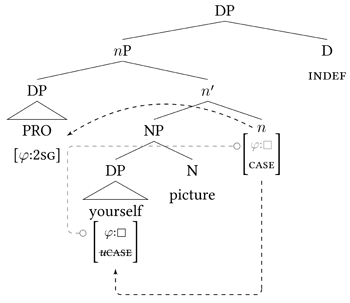
Analogous to v in the previous analyses, the φ-features transferred to the anaphor via n can also be realized on the noun after N-to-n movement.
Furthermore, the external argument of the noun can be realized overtly as a possessor, where it is optionally marked by a possessive morpheme viē (50).
- (50)
- Binding by possessor inside DP:
- a.
- Kēví
- Kevi
- [DP
- ā
- 1sg
- (viē)
- (poss)
- ā-thuó
- 1sg-self
- *(ā-)mhīrhī
- *(1sg-)picture
- ū
- def
- ]
- ŋú
- see
- ‘Kevi saw my picture of myself.’
- b.
- á
- 1sg
- [DP
- Kēví (viē)
- Kevi (poss)
- puō-thuó
- 3sg-self
- *(puō-)mhīrhī
- *(3sg-)picture
- ]
- ŋú
- see
- ‘I saw my Kevi’s picture of himself.’
In such cases, the possessor occupies the position of PRO in (49) and is again the source of the φ-features in the mediated Agree relation.
3.5 PP-internal anaphors
The object marker is also found with bound anaphors inside PPs. With the PP headed by the postposition gī (‘on’) in (51a), we see that P can also host the object marker if its complement is an anaphor (51b).
- (51)
- a.
- á
- 1sg
- lēʃə́dà
- book
- ū
- def
- [PP
- thēʒə́
- bed
- gī
- on
- ]
- pē-ʒə̋
- caus-lie
- ʃə́
- perf
- ‘I put the book on the table.’
- b.
- á
- 1sg
- lēʃə́dà
- book
- ū
- def
- [PP
- ā-thuó
- 1sg-self
- *(ā-)gī
- *(1sg-)on
- ]
- pē-ʒə̋
- caus-lie
- ʃə́
- perf
- ‘I put the book on myself.’
Similar facts obtain with the postposition zé (‘with’), which also hosts the object marker in (52b).
- (52)
- a.
- á
- 1sg
- [PP
- Kēví
- Kevi
- zé
- with
- ]
- léʃékí́
- school
- nū
- loc
- vő
- go
- ‘I went to school with Kevi.’
- b.
- á
- 1sg
- [PP
- ā-thuó
- 1sg-self
- *(ā-)zē
- *(1sg-)with
- ]
- léʃékí́
- school
- nū
- loc
- vő
- go
- ‘I went to school with myself.’
These observations also fit with the view that the object marker surfaces on heads which perform a licensing function. In keeping with the preceding analyses, we assume that the object of a preposition is licensed by a functional head p (see e.g. Svenonius 2003; 2010). Furthermore, let us posit, as we did for DPs, a PP-internal PRO that acts as the source of the φ-features for the anaphor.15 Similar to the other examples we discussed, we assume that the P head moves to p to combine with the affix morphologically.
- (53)
3.6 Psych-verbs
The final context where we find the object marker in Tenyidie involves what would usually be translated as predicate adjectives in English.For example, the equivalents of ‘happy’ (54a), ‘jealous’ (54b) and ‘tired’ (54c) all obligatorily have the object marker.
- (54)
- a.
- á
- 1sg
- *(ā-)ní́
- *(1sg.obj-)be.happy
- ba̋
- prog
- ‘I am happy.’
- b.
- Kēví
- Kevi
- *(puō-)rò
- *(3sg.obj-)be.jealous
- ba̋
- prog
- ‘Kevi is jealous.’
- c.
- nó
- 2sg
- *(n̄-)nyīȅ
- *(2sg.obj-)be.tired
- ba̋
- prog
- ‘You are tired.’
While this may look like subject agreement on an adjective, it is not the case that all predicative adjectives are marked in this way. The adjectives ví (‘good’), zīʃuò (‘ugly’) and kra̋ (‘white’) are all incompatible with the relevant object marker (55).
- (55)
- a.
- Kēví
- Kevi
- (*puō-)ví
- (*3sg.obj-)good
- bá
- prog
- ‘Kevi is good.’
- b.
- nó
- 2sg
- (*n̄-)zīʃuò
- (*2sg.obj-)ugly
- sè
- emph
- ‘You are ugly.’
- c.
- á
- 1sg
- (*ā-)kra̋
- (*1sg.obj-)white
- ‘I am white.’
Broadly speaking, the difference between the (54) and (55) is that the former correspond to psych verbs, i.e. predicates that describe a mental state or process. Thus, we will follow Giridhar (1980: 55ff.) in assuming that the examples in (54) are actually verbs. The presence of the object marker would then make sense if we are dealing with inherently reflexive psych verbs of the kind found in Germanic (e.g. Fanselow 1987; 1991; Schäfer 2008; 2012; Kallulli 2013) and Romance languages (e.g. Belletti & Rizzi 1988; Dobrovie-Sorin 2017). As (56) shows, certain psych predicates in German involve inherently-reflexive verbs with a genuine reflexive object (56).
- (56)
- a.
- Ich
- I
- freue
- please.1sg.pres
- mich
- myself
- ‘I am happy.’
- b.
- Er
- he
- schämt
- shame.3sg.pres
- sich
- himself
- ‘He is ashamed.’
We propose that the cases in (54) should also be analyzed as inherently-reflexive psych verbs. Since the anaphor acquires φ-features from its antecedent, we expect to find the object marker on v.
However, this analysis raises the question of why an overt reflexive is not possible in such examples such as (57).
- (57)
- a.
- á
- 1sg
- (*ā-thuó)
- (*1sg.obj-self)
- ā-ní́
- 1sg.obj-be.happy
- ba̋
- prog
- ‘I am happy.’
- b.
- Kēví
- Kevi
- (*puō-thuó)
- (*3sg-self)
- puō-rò
- 3sg-be.jealous
- ba̋
- prog
- ‘Kevi is jealous.’
To account for this, we assume that psych verbs merge with an obligatorily null reflexive object, which we notate as Ørefl. Crucially, Ørefl does not receive any phonological realization, perhaps due to it lacking the typical reflexive root thuó.
On this view, the example in (54a) would be analyzed as in (58).
- (58)
- á
- 1sg
- *(ā-)ní́
- *(1sg-)be.happy
- ba̋
- prog
- ‘I am happy.’
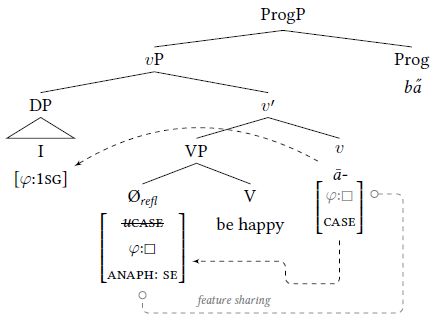
This essentially means positing two kinds of reflexive objects in Tenyidie: an overt complex anaphor and a null simplex anaphor. The two types of anaphors are distinguished by a lexical property we encode with the features [anaph: self] vs. [anaph: se], following the terminology in Reinhart & Reuland (1993). This distinction is found in other languages, too. For example, Dutch has two kinds of reflexives: the complex reflexive zichzelf and the simplex reflexive zich (59). As Reinhart & Reuland (1993) show, the complex anaphor zichzelf is incompatible with inherently reflexive verbs (59b).
- (59)
- a.
- Max
- Max
- haat
- hates
- *zich
- *refl
- /
- zich-zelf
- refl-self
- ‘Max hates himself.’
- b.
- Max
- Max
- schaamt
- shames
- zich
- refl
- /
- *zich-zelf
- *refl-self
- ‘Max is ashamed.’ (Reinhart & Reuland 1993: 665f.)
3.7 Interim summary
This section has shown that, in addition to verbs, both nouns and prepositions also show the object marker when its complement is an anaphor. This is problematic for the view that the object marker encodes some kind of reflexive voice. Furthermore, it supports the licensing agreement correlation that we proposed in (38) since we find the object marker on functional heads such as v, n and p, which are all licensing heads. In the following section, we will further support for this view.
4 Ditransitives
This section presents evidence from ditransitives in support of the proposal that there is a close link in Tenyidie between apparent ‘anaphoric agreement’ and nominal licensing. In particular, we will see that some otherwise puzzling restrictions on anaphors in double object constructions make sense in light of the present analysis.
4.1 The structure of ditransitives
The basic word order of a ditransitive in Tenyidie has the direct object (DO) preceding the (IO) (60a). The reverse order (IO before DO) is not possible with the same reading (60b).
- (60)
- Double object constructions have neutral DO-IO order:
- a.
- á
- 1sg
- lēttēr
- letter
- ū
- def
- Kēví
- Kevi
- pēkiē
- show
- ʃə́
- perf
- ‘I showed Kevi the letter.’
- b.
- *á
- 1sg
- Kēví
- Kevi
- lēttēr
- letter
- ū
- def
- pēkiē
- show
- ʃə́
- perf
- ‘I showed Kevi the letter.’
To account for this word order, we assume that double object constructions in Tenyidie have a left-branching structure, with the IO hosted in a rightward specifier of ApplP (see Bruening 2010b for a similar assumption).
- (61)
- [ApplP [Appl′ [VP DO V ] Appl ] IO ]
This structure is supported by evidence from scope. As (62) shows, the IO takes scope over the DO, despite following it linearly. The alternative scope relation is judged to be far less natural here.
- (62)
- Scope relations in ditransitives:
- Á
- 1sg
- [DP
- bāll
- ball
- può
- indef
- ]
- [DP
- nhīcű-jő
- child-dim
- puòpuò
- every
- kēcə́
- prt
- ]
- tsə̀
- give
- ʃə́
- perf
- ‘I gave every child a ball.’ (∀ ≻ ∃, ??∃ ≻ ∀)
This follows naturally from the structure in (61), since the IO c-commands the DO in its base structure.16 This can be seen more clearly in the tree in (63), where we also assume head movement of the verb to v to derive the correct surface word order.
- (63)
As we have seen, the subject moves on to Spec-TP, however this will not be relevant for the following discussion.
4.2 Anaphora in ditransitives
With the structure of ditransitives in place, we now observe an interesting restriction on anaphora in double object constructions in Tenyidie. While the indirect object can be an anaphor bound by the subject (64a), the direct object cannot (64b).
- (64)
- Reflexive must be IO not DO:
- a.
- ái
- 1sg
- lēttēr
- letter
- ū
- def
- ā-thuói
- 1sg-self
- ā-pēkiē
- 1sg-show
- ʃə́
- perf
- ‘I showed the letter to myself.’
- b.
- *ái
- 1sg
- ā-thuói
- 1sg-self
- Kēví
- Kevi
- (ā-)pēkiē
- 1sg-show
- ʃə́
- perf
- ‘I showed myself to Kevi.’
In order to see how this restriction follows under the present account, we must first establish how licensing works in double object constructions. It is often assumed that there are in principle two licensing configurations for the internal arguments of a ditransitive verb and that the choice between them is subject to language-specific parametric variation (Haddican & Holmberg 2018:100; Holmberg et al. 2019:686f.). The first involves licensing by Appl of the IO in its specifier and downward licensing of the DO by v. The alternative is to have the uniformly downward licensing relations with v licensing the IO and Appl licensing the DO. We will assume that Tenyidie has uniformly downward licensing relations with Appl licensing the direct object and v licensing the indirect object (see Georgala et al. 2008; Haddican & Holmberg 2018; van der Wal 2020; and also Adger & Harbour 2007:24 on agreement).
Recall that, given our present assumptions about binding, a reflexive anaphor must receive φ-features from its antecedent, mediated by the head that licenses the anaphor. Since v licenses the indirect object, it creates the necessary feature sharing dependency required to transfer the φ-features from the external argument to the anaphor, as shown in (65).
- (65)
- ái
- 1sg
- lēttēr
- letter
- ū
- def
- ā-thuói
- 1sg-self
- ā-pēkiē
- 1sg-show
- ʃə́
- perf
- ‘I showed the letter to myself.’

The direct object, on the other hand, is licensed by Appl. A consequence of this is that there is no mediated Agree relation between the anaphor and its antecedent (the subject). Thus, while feature-sharing between Appl and the DO can be established, the φ-features of the subject cannot be transferred to the DO and, as a result, the example in (66) cannot be derived.
- (66)
- *ái
- 1sg
- ā-thuói
- 1sg-self
- Kēví
- Kevi
- (ā-)pēkiē
- 1sg-show
- ʃə́
- perf
- ‘I showed myself to Kevi.’
-
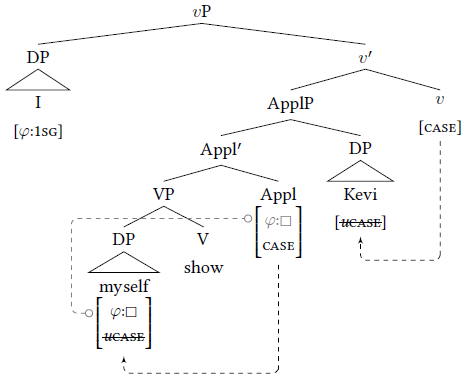
Thus, the dependency of reflexive binding on a prior licensing relation to mediate the transfer of φ-features can explain this asymmetry in double object constructions.17
4.3 Dative alternation
Like English, Tenyidie also has a dative alternation. Although we saw in (64b) that it is typically not possible for the IO precede the DO, this option becomes available if the IO is marked by kí (67b), as also noted by Kevichüsa (2007) and Subbārāo (2012: 21f.).
- (67)
- IO-DO order requires ki-marking:
- a.
- á
- 1sg
- lēttēr
- letter
- ū
- def
- Kēví
- Kevi
- pēkiē
- show
- ʃə́
- perf
- ‘I showed Kevi the letter.’
- b.
- á
- 1sg
- Kēví1
- Kevi
- kí
- ki
- lēttēr
- letter
- ū
- def
- ____1
- pēkiē
- show
- ʃə́
- perf
- ‘I showed the letter to Kevi.’
We analyze kí as a postposition (Subbārāo 2012: 21 refers to it as a dative marker). As (68b) shows, the availability of ki-marking appears is linked to a change in word order; the ki-marked goal argument must precede the theme. Concretely, we analyze this as the result of short movement of the IO to a structurally-higher position. We assume that it is this movement that leads to the insertion of kí. This is reminiscent of Dependent Case assignment under movement to a local domain with a higher argument, e.g. in Sakha (Baker & Vinokurova 2010). While this can be implemented as Dependent Case, we opt for a different implementation in terms of what Richards (2010) calls Distinctness.
Richards (2010) argues that two non-distinct phrases cannot occur in the same Spell-Out domain (i.e. the same phase), since this leads to a linearization problem. For example, two DPs in the same Spell-Out domain would lead to a linearization statement such as ⟨DP, DP⟩, which violates the general Distinctness requirement. He shows that a vast array of linguistic phenomena can be explained in this way. Among other things, he treats Differential Object Marking (DOM) as a Distinctness repair. In Chaha, for example, specific indefinites bear a special marker yǝ- (68a), which is not found with nonspecific indefinites (68b).
- (68)
- Differential Object Marking in Chaha (Richards 2010: 26):
- a.
- Gɨyǝ
- dog
- yǝ-fǝrǝz
- ye-horse
- nǝkwǝsǝnim
- bit
- ‘A dog bit a (specific) horse.’
- b.
- Gɨyǝ
- dog
- fǝrǝz
- horse
- nǝkwǝsǝnim
- bit
- ‘A dog bit a (nonspecific) horse.’
Richards (2010: 27f.) argues that (68a), and similar patterns of DOM, result from scrambling of an indefinite to a higher position to receive a specific interpretation (e.g. Diesing 1992). This higher position places the object in the same Spell-Out domain as the subject and, in order to satisfy Distinctness, a functional projection headed by yǝ is adjoined to the object. Richards assumes that this is a K(ase)P in (68a), but what is actually important is that it is a phase head, since this additional functional projection crucially introduces an additional phase boundary and leads to the DPs being linearized in different Spell-Out domains.
Taken together, we draw on these assumptions for the analysis of ki-marking. In (67), we clearly see that ki-marking involves a change in word order, which can be viewed as movement of the indirect object to a higher position (though see (79) for discussion of an alternative).18
We propose that alongside v and C, Appl is also a phase head in Tenyidie (e.g. McGinnis 2001). Consequently, in its base-position, the indirect object is in a different Spell-Out domain to both the direct object and the subject. Scrambling it to a higher position, however, places it in the same Spell-Out domain as the subject (the phase complement of C) and would therefore lead to a Distinctness violation. To avoid this, we assume that the P head kí is late-adjoined to the DP as a repair (69).
- (69)
Following Richards (2010), we also assume that P is a phase head (also see Abels 2012).19 This means that, in (69), each of the DP arguments is in a separate Spell-Out domain and no Distinctness violation is incurred. This directly accounts for the link between word order and ki-marking.
Recall that binding of a direct object anaphor by the subject was ungrammatical in the non-shifted ditransitive frame (66). If the IO is moved and ki-marked as in (69), however, binding of the DO now becomes possible (70).
- (70)
- Reflexive DO possible if IO is scrambled:
- ái
- 1sg
- Kēví
- Kevi
- kí1
- ki
- ā-thuói
- 1sg-self
- ____1
- ā-pēkiē
- 1sg-show
- ʃə́
- perf
- ‘I showed myself to Kevi.’
This follows on the present analysis. In the dative-shift construction, the IO has been moved out of the way so that v can license the DO anaphor and thereby establish the necessary mediated Agree relation with its antecedent (71).20
- (71)
The IO in (71) is licensed by the postposition kí that is inserted as part of the Distinctness repair outlined above.21 This raises more general questions about the distribution of licensers. For example, why does Appl not bear a Case probe in (71)? If it did, this would be problematic in light of the Inverse Case Filter (Bošković 1997; 2002), for example, where all Case-assigning probes must be checked.
In this regard, we broadly follow the assumptions about nominal licensing laid out in Kalin (2018). She proposes that ‘clauses typically have just one obligatory licenser (always merged), with secondary licensers merging only when needed for convergence’ (Kalin 2018: 115). This is captured by (72).
- (72)
- Licensing Economy Principle (Kalin 2018: 169):
- A secondary licenser is activated iff the derivation will not otherwise converge.
For Tenyidie, we assume that the primary licenser in the vP domain is v. Since licensing involves Agree in Case features, this means that v always enters the derivation with a [case] probe. For ditransitive verbs, an additional licenser will be required for the other internal argument. Given (72), this means that an additional Case feature can be added to the derivation in such cases. In the unmarked case, this additional licenser will be merged on Appl, which will agree with the DO as in (81a). Since the licensing feature on Appl is not inherent, its function can instead be fulfilled by adding a licensing feature to the P head kí (or p, to be precise) in (71). The economy condition in (72) dictates that there cannot be a feature on both Appl and P, since only one of them is required to license the additional internal argument.
This of course raises the question of how to implement the Licensing Economy Principle. As a reviewer notes, if this economy principle were implemented locally, then it would require Look Ahead in a structure like (71) (also see Kalin 2018: 139, 140, fn. 15). This is because a licenser on Appl can only be omitted if a secondary licenser on P is going to be merged later. Since this kind of Look Ahead is undesirable, Kalin (2018) suggests that the Licensing Economy Principle should be treated as a global or transderivational constraint (comparing derivations).
That said, it does seem possible to implement this as a local constraint if we compare existing solutions to other Look Ahead problems in syntax. A classic example of Look Ahead involves the distribution of edge features in successive-cyclic movement. In a phase-based approach, all phase heads along a movement path must be endowed with an edge feature before the final landing site of movement has been determined, therefore seemingly requiring Look Ahead (see e.g. Bošković 2007). Heck & Müller (2003: 105) propose a solution to this problem in the form of a constraint Phase Balance. What Phase Balance essentially does is check that the number of available goal features (e.g. F) at the phase level matches the number of corresponding probe features (e.g. uF) in the remaining numeration. If not, then an edge feature is inserted. Assuming that the numeration is part of the derivation, this computation is local. For economy of licensers, a similar approach could be adopted. As a constraint on the numeration, the number of licensing [case]-features must match the number of licensee [ucase]-features borne by the core arguments. Assuming only v as an inherent licenser, a ditransitive argument structure will lead to an imbalance and therefore permit insertion of exactly one secondary licensing feature on a given head. In (71), we saw that this additional licenser can be on P/p, but it could equally well be added to Appl instead, as we saw in (81a).
4.4 Binding from the indirect object
The restriction that a DO anaphor cannot ordinarily be bound by the subject (66) was argued to follow from the lack of a mediated relation between its canonical licenser Appl and the external argument. While this can be circumvented, as the previous section showed, by recruiting an alternative licenser for the IO in the form of kí, a clear prediction is that binding of a DO anaphor from the indirect object should be unproblematic. This is because the IO is introduced in Spec-Appl and should therefore allow for mediated transfer of φ-features to the anaphor via the Appl head.
This prediction is not straightforwardly borne out, however. As (73a) shows, the IO cannot bind the DO from its base position and the sentence is ungrammatical. When the IO undergoes object shift and obtains the concomitant ki-marking, however, then binding of the anaphor is possible (73b).
- (73)
- IO can bind anaphor in shifted position:
- a.
- *á
- 1sg
- puō-thuói
- 3sg-self
- Kēvíi
- Kevi
- (puō-)pēkiē
- (3sg-)show
- ʃə́
- perf
- ‘I showed Kevi himself.’
- b.
- á
- 1sg
- [PP
- Kēvíi
- Kevi
- kí
- ki
- ]1
- puō-thuói
- 3sg-self
- ____1
- *(puō-)pēkiē
- *(3sg-)show
- ʃə́
- perf
- ‘I showed himself to Kevi.’
At first, this may seem like a puzzling restriction, however it follows from an independent property of the language. In Tenyidie, it is generally the case that an R-expression may not be linearly preceded by an element that is referentially dependent on it. This is a configuration that has been termed backward anaphora (e.g. Ross 1967; Langacker 1969) and seems to be uniformly prohibited in Tenyidie. Sulemana (2019) reports a similar restriction in Bùlì and proposes the following constraint to capture it (74).
- (74)
- Backward Anaphora Constraint (Sulemana 2019:18):
- An R-expression may not be linearly preceded by a nominal co-indexed with it.
This constraint also seems to be active in Tenyidie. For example, a possessive pronoun cannot be construed as co-referent with an R-expression that it linearly precedes (75a). This is striking, since this cannot be attributed to Condition C due to the lack of c-command (comparable examples have been reported as grammatical in English). Thus, it seems necessary to appeal to something like (74) to rule it out. Furthermore, while we saw in (12) that an anaphor can undergo rightward displacement, leftward movement is ungrammatical (75b). This is equally ruled out by (74).22
- (75)
- No backward anaphora in Tenyidie:
- a.
- *[DP
- puōi
- 3sg
- ʒuó
- mother
- ]
- Kēvíi
- Kevi
- khrié
- love
- ba̋
- prog
- ‘Hisi mother loves Kevii.’
- b.
- *ā-thuói
- 1sg-self
- ái
- 1sg.sbj
- ____I
- ā-tshē
- 1sg-praise
- ba̋
- prog
- ‘Myself, I am praising.’
In light of this, the necessity of scrambling in (73) becomes apparent. In its base-position (73a), the IO is linearly preceded by the anaphor it binds, in violation of the Backward Anaphora Constraint. This constraint can be satisfied by scrambling the IO to a higher-position where it precedes the DO in (73b).23 In the first step of this derivation in (76), the DO is licensed by v. Here, the secondary licensing feature must be situated on Appl rather than P in order to facilitate feature transfer from the IO to the DO. Thus, the IO is licensed in its base-position, leading to a successful mediated Agree relation with the anaphor via Appl, as shown in (76).
- (76)
- á
- 1sg
- [PP
- Kēví
- Kevi
- ki
- ki
- ]1
- puō-thuó
- 3sg-self
- ____1
- *(puō-)pēkiē
- *(3sg-)show
- ʃə́
- perf
- ‘I showed Kevi himself.’
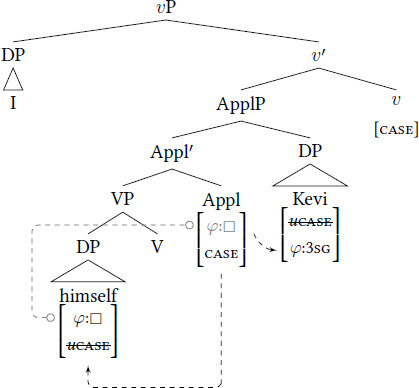
After binding has been established, the IO must be moved to a higher position in order to generate a surface structure that is compliant with the Backward Anaphora Constraint. As we have seen, ki-marking is the result of a Distinctness repair when the IO is placed in the same Spell-Out domain as the subject. Thus, a PP shell (including the functional structure of p) is adjoined to the IO in its derived position (77). Since Appl is a secondary licenser, p has no Case-licensing function here.
- (77)
This analysis requires that ki is adjoined ‘late’ in the derived position in order for valuation of the φ-feature on Appl to be possible under selection with the antecedent, as we have assumed so far. This is crucial as ki would otherwise serve as a barrier to selection by the relevant head. As a reviewer points out, this might at first seem to require an unorthodox conception of Late Merger. Typically, Late Merger involves countercyclic attachment of either preassembled adjuncts (Lebeaux 1988) or complements (Takahashi & Hulsey 2009). What we need in (77), however, is that the moved DP is the target of Late Merger of the P head kí and the functional head p. This kind of Late Merger operation has been proposed before, however, and is typically referred to as layering (e.g. Zwart 2009; Johnson 2012; de Belder & van Craenenbroeck 2015; O’Brien 2017; Thoms 2019). One possible implementation of layering relies on the idea that Internal Merge involves interarboreal or ‘sideward’ movement to another workspace. In this workspace, the moving phrase can have ‘layers’ added to it that were not present in the base position. The full phrase is then re-merged from the workspace back into the main derivation.24
To see this, it is instructive to switch to a multidominant representation of movement. The tree in (77) can also be depicted as in (78). First, the antecedent ‘Kevi’ is merged in Spec-ApplP where it is an argument selected by Appl. Given that Appl licenses the DO anaphor, mediated Agree is successful. In undergoing movement to Spec-vP, the IO ‘Kevi’ temporarily moves to a separate workspace where it is merged as the complement of kí. Subsequently, the associated functional material can be added on top. The resulting pP is then re-merged as the inner specifier of vP in the main workspace of the derivation, leading to the representation in (78).
- (78)
This analysis captures the fact that, despite being the complement of ki, a moved indirect object can still bind a direct object reflexive (77). This is because, in its base position, the DP has not yet been merged with the PP shell and is therefore fully accessible for Agree/valuation under selection.
This is relevant when we consider an alternative analysis suggested by a reviewer. The reviewer contends that one does not need to invoke movement at all for ki-marking if one instead assumes that Appl can select either a rightward or leftward specifier. By assumption, Appl only selects for a PP headed by ki in a rightward specifier. On this alternative analysis, subject binding would look as in (79).
- (79)
- a.
- b.
Recall that the configuration in (79a) is ungrammatical. This must be beacuse the DP in the leftward specifier intervenes for Agree when v probes downward by virtue of bearing a [uCase] feature. Unlike in the movement analysis, the DP complement of ki also remains within the c-command domain of v and must therefore not be syntactically accessible to v, otherwise it would intervene for Agree with the IO (possibly defectively). One possible reason for this is that ‘Kevi’ is not accessible to v (e.g. because PP constitutes a barrier) or because ki has already Case-licensed its sister.
This analysis runs into a problem, however, when the binder for the DO reflexive is the indirect object as in (73a), repeated below.
- (80)
- á
- 1sg
- [PP
- Kēvíi
- Kevi
- kí
- ki
- ]1
- puō-thuói
- 3sg-self
- ____1
- *(puō-)pēkiē
- *(3sg-)show
- ʃə́
- perf
- ‘I showed himself to Kevi.’
Since binding by IO is only possible when it is ki-marked, this example would have a structure like (79b), except Appl would have to be the head licensing the DO. Furthermore, Appl must create a mediated Agree-relation between the IO and the DO. We have assumed that the φ-features are transferred under selection (though Spec-Head Agree is in principle also a possibility here). Given the fact that ki-marked IO must necessarily be inaccessible outside of PP (for the reasons mentioned above), it is unclear how it can participate in the binding relation needed to establish (80). If the goal DP is encapsulated in a PP shell, it can not enter into the required relationship with Appl to facilitate binding. On the alternative Layering analysis in (78), this problem does not arise because the functional PP layer headed by ki is added only in the higher moved position. In its base position, the IO ‘Kevi’ is still accessible for Agree with Appl.
4.5 Binding within a ki-marked IO
A further option involves binding within the entire the ki-phrase. Recall that the IO itself can be an anaphor, as in (81a). Furthermore, we have seen that the goal argument can be moved and accompanied by kí. When the IO is an anaphor, it can also be moved and ki-marked (81b). Here, it is noteworthy that the object marker surfaces on the postposition, suggesting that it serves as the licensing head for the anaphor.
- (81)
- Alternative licensing for DO anaphor by P
- a.
- ái
- 1sg
- lēttēr
- letter
- ū
- def
- ā-thuói
- 1sg-self
- ā-pēkiē
- 1sg-show
- ʃə́
- perf
- ‘I showed myself the letter.’
- b.
- ái
- 1sg
- [PP
- ā-thuói
- 1sg-self
- ā-kí
- 1sg-ki
- ]
- lēttēr
- letter
- ū
- def
- pēkiē
- show
- ʃə́
- perf
- ‘I showed the letter to myself.’
As discussed in section 3.5, the presence of the object marker on an adposition signals the presence of a PRO argument inside the PP. We therefore assume that it is a PRO argument inside the PP in (80b) that creates the necessary mediated binding configuration to licensing the reflexive, as in (82). As before, we assume that the P head moves to p and combines with the affix hosted there.
- (82)
Examples such as (83) are then potentially ambiguous, since Kēví could in principle be the DO or the IO, since it is not thematically-restricted like the ‘the letter’ in (81b). If it were the IO, then the anaphor would have be the DO that has undergone ki-related movement.
- (83)
- ái
- 1sg
- [PP
- ā-thuói
- 1sg-self
- ā-kí
- 1sg-ki
- ]
- Kēví
- Kevi
- pēkiē
- show
- ʃə́
- perf
- ‘I showed Kevi to myself.’
We can show that this is not the case, however, as ki-marking is reserved for goal arguments. In cases where ‘the letter’ must be the DO, we can clearly see that it cannot be ki-marked (84b).
- (84)
- a.
- á
- 1sg
- [PP
- Kēví1
- Kevi
- kí
- ki
- ]
- lēttēr
- letter
- ū
- def
- ____1
- pēkiē
- show
- ʃə́
- perf
- ‘I showed Kevi the letter.’
- b.
- *á
- 1sg
- [PP
- lēttēr
- letter
- ū1
- def
- kí
- ki
- ]
- ____1
- Kēví
- Kevi
- pēkiē
- show
- ʃə́
- perf
- ‘I showed Kevi the letter.’
The only possible interpretation of (84b) is one in which the ‘the letter’ is the goal, which is necessarily semantically odd since the goal is presumed to be animate (see Oehrle 1976).
4.6 Serial verbs
There is yet another construction available for ditransitives in Tenyidie. Alongside the canonical ditransitive we have seen thus far (85a), there is also a variant involving the morpheme piē (85b).
- (85)
- a.
- á
- 1sg.sbj
- lēʃə́dà
- book
- può
- indef
- Kēví
- Kevi
- pēkiē
- show
- ʃə́
- perf
- ‘I showed Kevi a book’
- b.
- á
- 1sg.sbj
- lēʃə́dà
- book
- può
- indef
- piē
- pie
- Kēví
- Kevi
- pēkiē
- show
- ʃə́
- perf
- ‘I showed a book to Kevi’
The status of this additional piē element is rather puzzling. While it is tempting to analyze it as an additional verb, we suggest that this morpheme actually signals that a different structure is involved, namely a serial-verb construction. This is supported by the fact that, in addition to piē, it is possible to have a lexically-contentful verb. In (86a), the verb thu (‘write’) co-occurs with piē, followed later in the clause by tsǝ (‘give’) (86a). Furthermore, the transitive variant of ‘give’ kha can also co-occur with its ditransitive counterpart tsǝ (86b).
- (86)
- a.
- Kēví
- Kevi
- lēttēr
- letter
- può
- indef
- thú-piē
- write-pie
- n̄
- 2sg.obj
- tsə̀
- give
- ʃə́
- perf
- ‘Kevi wrote you a letter.’
- b.
- Kēví
- Kevi
- lēʃə́dà
- book
- può
- indef
- khà-piē
- give.tr-pie
- n̄
- 2sg.obj
- tsə̀
- give
- ʃə́
- perf
- ‘Kevi gave you a book.’
While one might want to assume that piē can form some kind of complex predicate with these verbs, note that piē cannot occur outside of this multi-verb construction (87).
- (87)
- a.
- Kēví
- Kevi
- lēʃə́dà
- book
- può
- indef
- khà(*-piē)
- give.tr(*-pie)
- ʃə́
- perf
- ‘Kevi gave a book.’
- b.
- Kēví
- Kevi
- lēttēr
- letter
- può
- indef
- thú(*-piē)
- write(*-pie)
- ʃə́
- perf
- ‘Kevi wrote a letter.’
With this is mind, we suggest that piē is actually the head of a coordination phrase &P. The variant of & that is realized as piē also selects for conjuncts of a particular size, namely vPs (see Keine 2013 for similar assumptions regarding switch reference marking).25 The analysis we assume for an example like (86a) is given in (88).
- (88)
Serial verb constructions are known to often involve object sharing (e.g. Baker 1989). For present purposes, we adopt a version of the proposal in Collins (1997) where the second object is realized as a pro, however the analysis is compatible with other approaches too (e.g. Hiraiwa & Bodomo 2008).
The Tenyidie construction also involves subject sharing. We aim to capture this by assuming, following Amaechi & Zimmermann (2019), that the subjects of each vP conjunct undergo ATB-movement to a single Spec-TP position. Thus, the low coordination signalled by piē gives rise to ‘deletion’ of the second subject via ATB (cf. Johnson 2009 on gapping). Finally, notice that the verb in the first conjunct appears to be optional, as we saw in (85b).
With this structure in place, consider now the options with anaphors in this construction (89). If the anaphor is the (indirect) object of the second verb (89a), then the object marker surfaces only on this verb. The same pattern arises with an anaphor in the first conjunct. In the absence of a lexical verb, the marker surfaces adjacent to piē (89b). This construction also allows for the anaphor to be realized twice. In this case, we find the object marker in each of the conjuncts (89c).
- (89)
- a.
- á
- 1sg.sbj
- lēʃə́dà
- book
- può
- indef
- (*ā-)piē
- (*1sg-)pie
- ā-thuó
- 1sg-self
- *(ā-)pēkiē
- *(1sg-)show
- ʃə́
- perf
- ‘I showed a book to myself.’
- b.
- á
- 1sg.sbj
- ā-thuó
- 1sg-self
- *(ā-)piē
- (*1sg-)pie
- Kēví(*ā-)pēkiē
- Kevi*(1sg-)show
- ʃə́
- perf
- ‘I showed myself to Kevi.’
- c.
- á
- 1sg.sbj
- ā-thuó
- 1sg-self
- *(ā-)piē
- *(1sg-)pie
- ā-thuó
- 1sg-self
- *(ā-)pēkiē
- *(1sg-)show
- ʃə́
- perf
- ‘I showed myself to myself.’
Given the structure in (88), each of the v heads licenses its object and can potentially create a mediated Agree relation with its local external argument. This can be seen most clearly for the complex example in (89a) as analyzed in (90).
- (90)
Since each of the anaphors is licensed by a v in its respective conjunct, this can account for the presence of two object markers. In the absence of an overt verb in the first conjunct, the phonologically-dependent, prefixal property of the object marker ā- forces it to ‘lean’ phonologically onto the following word (see Harley & Noyer 2003:483f.), which is the coordinator piē.
5 Conclusion
This paper has investigated apparent agreement with anaphors in Tenyidie. We have argued that, rather than constituting genuine φ-agreement, the φ-covarying morphology that we find in these constructions is actually an overt reflex of reflexive binding. In particular, the head responsible for licensing an anaphor will obtain a shared instance of its φ-feature. This head can value both occurrences of this shared feature if it introduces another argument in its specifier. We have shown that this view can account for various facts about anaphora in Tenyidie, namely why this putative agreement is found only with anaphors (but not other arguments), its compatibility with different licensing heads, and various restrictions found with ditransitives.
The analysis also has some broader consequences for our understanding of anaphora. First, it lends support to theories of reflexive binding involving φ-feature exchange under Agree (e.g. Reuland 2005; Kratzer 2009; Rooryck & Vanden Wyngaerd 2011). While Preminger (2019) has argued against such a position (also see Rudnev 2020), the exceptional agreement we find in Tenyidie provides morphological evidence that φ-features are involved in this relation. Furthermore, it supports a ‘mediated’ approach to binding under Agree (Heinat 2006; 2009), where the exchange of φ-features does not take place directly between an anaphor and its antecedent, but is facilitated by a functional head. Second, while Tenyidie may, at first glance, look like a counterexample to the Anaphor Agreement Effect, on the present analysis, it is not. This is because we are not dealing with genuine agreement involving a typical φ-probe. Since the object marker in Tenyidie is not a genuine agreement marker, this pattern simply falls outside the scope of the generalization.
To summarize, this investigation of anaphora in Tenyidie suggests that φ-covarying morphology may not always be agreement. Even if it can be shown to be an inflectional exponent, it may be realizing something other than a simple probe-goal relation. In this case, we argue that the object marker we find in local reflexivization contexts in Tenyidie reveals something deeper about the way reflexive binding works in the language.
Abbreviations
1 = 1st person, 2 = 2nd person, 3 = 3rd person, abs = absolutive, aux = auxiliary, caus = causative, cl = clitic, comp = complementizer, def = definite article, dim = diminutive, do = direct object, erg = ergative, excl = exclusive, f = feminine, imp = impersonal, io = indirect object, indef = indefinite article, loc = locative, fut = future, obj = object, om = object marker, m = masculine, n = neuter, perf = perfective, poss = possessive, pres = present, prt = particle, prog = progressive, prox = proximal, pst = past, refl = reflexive, sbj = subject, sg = singular, tr = transitive.
Notes
- As a reviewer points out, there are exceptions to this. For example, referential expressions contained in prepositional phrases seem to be able to bind anaphors that they do not c-command (i).
This is a general property of binding with elements contained in PPs that is also found with Condition C (*Sue spoke to himi about Bill’si mother; see Reinhart 1976; Pesetsky 1995: 177) and variable binding (They talked to every studenti about heri progress). Any approach to binding will therefore require some additional assumption about the structure of such phrases or the nature of c-command to accommodate this (e.g. almost c-command; Hornstein 1995: 108 or precede-and-command; Bruening 2014). [^]
- (i)
- I talked [PP to Maryi ] [PP about herselfi ]
- This is admittedly somewhat of an oversimplification. There are some cases in English where, if an anaphor and its potential binders are co-arguments of the same predicate, then either is a possible antecedent:
In such cases of apparent non-minimal antecedence, it has been argued that the anaphor has actually moved (possibly covertly) to a higher position where the subject is the closest potential binder (Kayne 1975; Pica 1987; Chomsky 1995; Safir 2004; Ahn 2015). This kind of movement is limited to co-arguments of the same predicate (perhaps for reasons of locality), which is why this option is unavailable in (3). [^]
- (i)
- Maryi assigned Janej to herselfi,j
- That said, proposing the same underlying mechanism (Agree) for both agreement and anaphora has also been criticized (see e.g. Safir 2014; Preminger 2019; Rudnev 2020; Bruening 2021). [^]
- The data in this paper come from the second author of the paper, who is a native speaker of Tenyidie. [^]
- Note that the omission of a third person singular anaphoric object is judged not to be acceptable under a reflexive interpretation (ia). We suspect that this is because, in a reflexive context, the object marker in is parsed as an object pronoun rather than an object marker associated with a null reflexive, as in (ib).
- (i)
- a.
- puōi
- 3sg
- *(puō-thuói)
- *(3sg-self)
- puō-tshē
- 3sg-praise
- ba̋
- prog
- ‘He is praising himself.’
While we might have expected to simply find ambiguity here, the unacceptability of argument ellipsis with 3rd person reflexive objects suggests that this ellipsis is constrained such as to avoid creating ambiguities of this kind. This may well be a language-specific property. As a reviewer points out, such an ambiguity is tolerated in Flemish Brabant Dutch where simplex reflexives (which are syncretic with weak object pronouns) allow both a reflexive and non-reflexive interpretation:- b.
- puōi
- 3sg
- puōj
- 3sg-self
- tshē
- 3sg-praise
- ba̋
- prog
- ‘He is praising him.’
[^]- (ii)
- Jani
- Jan
- heed
- has
- ‘mi/j
- him
- gewasse
- washed
- ‘Jan washed himj/himselfi’ (Rooryck & Vanden Wyngaerd 2011: 35)
- Note that leftward displacement of an anaphor is ruled out by a general constraint against backward anaphora in the language (see section 4.4 for further discussion). [^]
- That said, this diagnostic is not entirely conclusive. For example, Baker & Kramer (2018) show that there is a Minimality effect with clitic doubling in Amharic, which they interpret as showing that Agree is involved as part of the process (also see Harizanov 2014). [^]
- This bundling of index and φ-features has some intuitive appeal as it accounts for the fact that φ-matching seems to constitute a more general restriction on coreference (see Sag et al. 2003:208; Collins & Postal 2012:16). Even cross-sentential anaphora involving pronouns is often subject to a constraint where a φ-match is required for co-reference, which can be achieved with a condition that requires matching of the entire feature geometry including the index feature. [^]
- One might wonder what the consequences are of having index features on an agreement target such as a functional head T or v, since we might expect these features to be realized by the morphology.A good candidate for this is so-called switch reference marking, which tracks whether two clauses have the same or different subjects. On some recent analyses of switch reference (e.g. Clem to appear; Arregi & Hanink to appear), a morpheme expresses whether or not the DPs that a functional head has agreed with bear the same referential index (though see Baker & Camargo Souza 2020 for a slightly different view). This is then a potential case where the index feature is indeed spelled-out on a functional head. [^]
- One might wonder about the general applicability of this constraint in other languages. It seems possible that it could be generalized such that whenever there is Agree with unvalued feature, we establish feature-sharing. Such an approach could help to solve some of the problems associated with Agree-based analyses of concord (see Danon 2011). [^]
- In general, it is possible (given certain assumptions about Bare Phrase Structure) that the φ-features of the anaphoric object would also be present on maximal projection of the head that licenses it and therefore also a potential goal for Agree, see Paparounas & Akkuş (2021) for a recent analysis along these lines. [^]
- We limit the discussion here to reflexive anaphors. We have not yet been able to investigate reciprocal constructions in detail, however the relevant way of expressing a reciprocal meaning is given in (i).
At present, we are unsure about the status of the morpheme niē and whether these reciprocals are subject to the same restrictions as reflexives. It is also worth noting that bound variable pronouns do not lead to the object marker on the matrix, for example. This is relevant because some authors have argued that these bear unvalued φ-features valued under Agree (e.g. Kratzer 2009; Grano & Lasnik 2018). This could still be the case in Tenyidie, however the Agree relation between the pronoun and its binder would be direct, rather than mediated. [^]
- (i)
- ūkō
- 3pl
- ūkō-thuó
- 3pl-self
- huò-niē-huò
- some-nie-some
- tshē
- praise
- ba̋
- prog
- ‘They are praising each other.’
- While we believe that this ECM due to similar constructions in other languages, if this is actually object control, then it would still follow under our analysis, but would not constitute an argument against a Reflexive Voice analysis (thanks for a reviewer for pointing this out). [^]
- On the PRO approach, it is possible to assume that the φ-features of PRO are valued in the numeration and, as Landau (2000: 62) suggests, thus ‘require identification (i.e. co-indexing) but not valuation’. This would be akin to a checking approach, where control involves Agree between the controller and PRO, without valuation. An alternative would be to assume a valuation approach under Agree in which PRO receives its φ-features under Agree with the controller (Landau 2000; Sigurðsson 2008; Ussery 2008). On this view, the feature-sharing dependency between the anaphor and v will be extended to PRO, which would also bear unvalued φ-features on this view. All instances would then be valued simultaneously once the controller establishes an Agree relation with PRO. Also, while it has been suggested that this relation can be mediated by a functional head (e.g. Landau 2004; 2008; van Urk 2013), it crucially does not involve licensing and, as such, will not be relevant for the feature sharing condition in (28). [^]
- Some motivation for PRO inside PPs comes from the status of PPs as individual binding domains (Chomsky 1981; 1986; Hestvik 1991):
As (i) shows, a bound pronoun inside the PP does not lead to a Condition B effect. This makes sense if the presence of a PRO in (i) renders the PP a Complete Functional Complex in the sense of Chomsky (1986) and thus its own binding domain. We tentatively assume that PPs in Tenyidie need not express a figure/ground relation (Svenonius 2010), but also that a postposition can take a PRO controlled by a deictic perspective holder as its specifier, as suggested by (Bruening 2014: 381, fn. 26). [^]
- (i)
- Johni saw a snake [PP PRO near himi ] (Chomsky 1981: 291)
- Also note that scope is frozen in this construction. This could result from the presence of ApplP, following Bruening’s (2001; 2010a) analysis of scope freezing in English ditransitives. Note that other classic diagnostics for the structure of ditransitives such as variable binding (Barss & Lasnik 1986) are not applicable for independent reasons. For example, binding of DO by IO fails due to a general constraint against backward anaphora in the language (see section 4.6 and footnote 22 for further discussion). [^]
- Note that this asymmetry is problematic for other approaches to binding such as Kratzer (2009). In Kratzer’s proposal, binding of DO anaphors is also facilitated by v, however she takes a different approach. For a sentence like I blame myself, the reflexive is interpreted as a free individual variable [n]. A binder for this variable is introduced by v (i). This turns the VP into a reflexive predicate (ia) (cf. Reinhart & Reuland 1993). The VP can now compose with the meaning of v in (ib) via Predicate Modification (ic).
- (i)
- [vP I [v′ v [ λ[n] [VP blame [n] ]]]]
- a.
- ⟦λ[n] [VP blame [n] ]⟧ = λyλe. blame(y)(e)
- b.
- ⟦v⟧ = λxλe. agent(x)(e)
Feature transmission from the anaphor is assumed to involve unification with v followed by Spec-Head Agreement with the antecedent (i.e. Predication) (Kratzer 2009: 195f.). Crucially, Kratzer’s account predicts that ‘any argument position within a sister VP should be accessible for binding from a given v’ (Kratzer 2009: 194). No asymmetry between indirect and direct objects is expected on this analysis, in contrast to the licensing-based proposal advocated here. [^]- c.
- ⟦v′⟧ = λxλe. blame(x)(e) ∧ agent(x)(e)
- We assume that scrambling of the IO targets an inner specifier of v, i.e. it precedes External Merge of the subject (see Heck & Himmelreich 2017). An alternative is possible, however, in which the moved object lands in a position above the base position of the subject. However, this might predict that ki-marked phrases can take exceptional wide scope above the subject if such scope involves reconstruction of the subject to its base position (see e.g. Johnson & Tomioka 1998). While we have not been able to carefully test reconstruction in Tenyidie, this prediction does not appear to be borne out. Nevertheless, on our analysis, the subject occupies no position below the object that could create this scope relation. Quantifier float may also provide a relevant diagnostic for the base position of the subject relative to ki-phrases, however this does not seem to be an option in Tenyidie. [^]
- As a reviewer points out, we do not have independent evidence for the phasehood of P/p heads in Tenyidie. While many of the relevant diagnostics prove difficult to apply to PPs, crosslinguistically, PPs do indeed pass some relevant phasehood diagnostics (see Citko 2014: 151; van Urk 2020: 118–124). As with ApplP, we rely heavily on this cross-linguistic evidence as our justification for treating PPs and ApplPs as phasal domains. [^]
- The derivation in (71) raises some questions about cyclicity and the timing of operations. In order for the indirect object not to intervene for licensing of the direct object, it must move to Spec-vP before v probes downwards to check its case feature. This is a familiar derivational scenario that Anand & Nevins (2006) call ‘punting’ and has been used in the analysis of agreement with nominative objects in Icelandic, for example (Holmberg & Hróarsdóttir 2003; Sigurðsson & Holmberg 2008). Whether or not this derivation is countercyclic depends largely on our definition of the cycle (McCawley 1984; Richards 1999). If cyclic nodes are maximal projections (rather than all projection levels), then downward Agree from v after merging its specifiers is not countercyclic. This can be achieved by extrinsic ordering of features on v, for example (see Müller 2009; Assmann et al. 2015). [^]
- Note that, as shown in section 3.5, it is actually a functional head p that licenses the object of the preposition. In the following discussion, we still assume this to be the case, but will simplify the representation of most of the structures in this way. It is worth mentioning that ki serves two functions in our analysis (or ‘double duty’ as a reviewer puts it). On the one hand, it insulates the IO from a Distinctness violation after it moves into the same local domain as the external argument. On the other hand. it may also function as an additional case assigner, when Licensing Economy dictates such. A reviewer suggests that this is tantamount to saying that there are actually two kí‘s in Tenyidie, one with a licensing function and one without (the same argument applies to Appl, too). We do not think it is necessary to assume two distinct heads, and instead prefer to view this as there being a single lexical entry for each head, coupled with the option of adding a [case]-probe to a given head regulated by economy considerations (as we outline below). [^]
- A further piece of evidence for the activity of this constraint comes from variable binding in ditransitives. A bound variable pronoun must take the impersonal form of the pronoun u- (analogous to one(‘s) in English). Despite the requisite c-command relation, an IO cannot bind a variable in the DO from its base-position (ia). Applying object shift to a ki-marked position, however, renders binding grammatical (ib). This also follows from the backward anaphora constraint.
- (i)
- a.
- *á
- 1sg
- [DP
- (ūi-thió)
- (imp-self)
- ūi-ʒuó
- imp-mother
- ]
- [DP
- thēmiè
- person
- puòpuòi
- every
- kēcə́
- prt
- ]
- pēkiē
- show
- ʃə́
- perf
[^]- b.
- á
- 1sg
- [PP [DP
- thēmiè
- person
- puòpuòi
- every
- kēcə́
- prt
- ]
- kí
- ki
- ]
- [DP
- (ūi-thió)
- (imp-self)
- ūi-ʒuó
- imp-mother
- ]
- ____IO
- pēkiē
- show
- ʃə́
- perf
- ‘I showed everyonei hisi mother.’
- A reviewer wonders whether it is equally possible to satisfy the Backward Anaphora Constraint by displacing the reflexive object to the right, an option that we already saw in (12). This does not seem to improve the example in (73a), however. This is presumably linked to the restriction noted in footnote 5, however the same effect is found without 3rd person objects. At present, we are unsure about why a right dislocated object still seems to violate the Backward Anaphora Constraint. It is possible that this is due to reconstruction, though this would undermine the surface-oriented nature of the constraint. It could also be that there is a syntactic explanation, e.g. that a DO cannot move across the closer IO due to a Minimality constraint. We leave this as an open issue for future research. [^]
- For example, Thoms (2019) argues that certain kinds of antireconstruction effects follow from the functional projections NumP and DP being merged to the noun only after it has moved from its base position. Also, see Johnson (2012; 2016) on the interpretation of layered structures. [^]
- Note that coordination of larger conjuncts involving independent subjects leads to a different coordinator mú (i).
[^]
- (i)
- [á
- 1sg.sbj
- n̄
- 2sg.obj
- thsē
- praise
- ba̋]
- prog
- mú
- and
- [nó
- 2sg.sbj
- Kēví
- Kevi
- thsē
- praise
- tiō]
- fut
- ‘I am praising you and you will praise Kevi.’
Acknowledgements
For helpful feedback and comments we are grateful to audiences at NELS 50 at MIT, GLOW 42 in Oslo, DISCO in Leipzig, and the colloquium at CRISSP KU Leuven. Particular thanks go to three anonymous reviewers at Glossa for their invaluable feedback on earlier versions of the paper.
Competing interests
The authors have no competing interests to declare.
References
Abels, Klaus. 2012. Phases: An essay on cyclicity in syntax. Berlin: de Gruyter. DOI: http://doi.org/10.1515/9783110284225
Adger, David. 2003. Core syntax. Oxford: Oxford University Press.
Adger, David & Harbour, Daniel. 2007. Syntax and syncretisms of the Person Case Constraint. Syntax 10(1). 2–37. DOI: http://doi.org/10.1111/j.1467-9612.2007.00095.x
Ahn, Byron. 2015. Giving reflexivity a voice: Twin reflexives in English: University of California Los Angeles dissertation.
Akkuş, Faruk. 2021. Variable embedded agent in Sason Arabic. Journal of Linguistics 57(2). 233–277. DOI: http://doi.org/10.1017/S0022226720000493
Amaechi, Mary & Zimmermann, Malte. 2019. The syntax and event semantics of serial verb constructions in Igbo. Ms. Universität Potsdam.
Anagnostopoulou, Elena. 2001. Two classes of double object verbs: The role of zero-morphology. In van Oostendorp, Marc & Anagnostopoulou, Elena (eds.), Progress in grammar, 1–27. Amsterdam: Roquade.
Anagnostopoulou, Elena. 2003. The syntax of ditransitives: Evidence from clitics. Berlin: de Gruyter.
Anagnostopoulou, Elena. 2016. Clitic doubling and object agreement. In Fischer, Susann & Navarro, Mario (eds.), Proceedings of the VII Nereus International Workshop, 11–42. Konstanz: Fachbereich Sprachwissenschaft.
Anand, Pranav & Nevins, Andrew. 2006. The locus of ergative case assignment: Evidence from scope. In Johns, Alana & Massam, Diane & Ndayiragije, Juvenal (eds.), Ergativity: Emerging issues, 3–27. Dordrecht: Kluwer. DOI: http://doi.org/10.1007/1-4020-4188-8_1
Antonenko, Andrei. 2012. Feature-based binding and phase theory: Stony Brook University dissertation.
Antonenko, Andrei. 2018. Principle A and feature valuation. In Farrell, P. (ed.), Proceedings of the Linguistic Society of America, vol. 3, 37, 1–15. Washington, D.C.: LSA. DOI: http://doi.org/10.3765/plsa.v3i1.4325
Arregi, Karlos & Hanink, Emily. to appear. Switch reference as index agreement. Natural Language and Linguistic Theory. DOI: http://doi.org/10.1007/s11049-021-09521-2
Assmann, Anke & Georgi, Doreen & Heck, Fabian & Müller, Gereon & Weisser, Philipp. 2015. Ergatives move too early: On an instance of opacity in syntax. Syntax 18(4). 343–387. DOI: http://doi.org/10.1111/synt.12034
Bader, Monika. 2011. Constraining operations: A phase-based account of improper movement and anaphoric binding: University of Tromsø dissertation.
Baker, Mark. 1996. The polysynthesis parameter. New York: Oxford University Press.
Baker, Mark & Camargo Souza, Livia. 2020. Agree without agreement: Switch-reference and reflexive voice in two Panoan languages. Natural Language and Linguistic Theory 38(4). 1053–1114. DOI: http://doi.org/10.1007/s11049-019-09463-w
Baker, Mark & Kramer, Ruth. 2018. Doubled clitics are pronouns: Amharic objects (and beyond). Natural Language and Linguistic Theory 36(4). 1035–1088. DOI: http://doi.org/10.1007/s11049-018-9401-8
Baker, Mark & Vinokurova, Nadya. 2010. Two modalities of case assignment: Case in Sakha. Natural Language and Linguistic Theory 28(3). 593–642. DOI: http://doi.org/10.1007/s11049-010-9105-1
Baker, Mark C.. 1989. Object sharing and projection in serial verb constructions. Linguistic Inquiry 20(4). 513–553.
Baker, Mark C.. 2012. On the relationship of object agreement and accusative case: Evidence from Amharic. Linguistic Inquiry 43(2). 255–274. DOI: http://doi.org/10.1162/LING_a_00085
Baker, Mark C.. 2016. On the status of object markers in Bantu languages. Ms. Rutgers University.
Barss, Andrew & Lasnik, Howard. 1986. A note on anaphora and double objects. Linguistic Inquiry 17(2). 347–354.
Béjar, Susana & Rezac, Milan. 2009. Cyclic Agree. Linguistic Inquiry 40(1). 35–73. DOI: http://doi.org/10.1162/ling.2009.40.1.35
Belletti, Adriana & Rizzi, Luigi. 1988. Psych-verbs and θ-Theory. Natural Language and Linguistic Theory 6(3). 291–352. DOI: http://doi.org/10.1007/BF00133902
Boeckx, Cedric & Hornstein, Norbert. 2004. Movement under Control. Linguistic Inquiry 35(3). 431–452. DOI: http://doi.org/10.1162/002438999553968
Boeckx, Cedric & Hornstein, Norbert & Nunes, Jairo. 2010. Control as movement. Cambridge: Cambridge University Press. DOI: http://doi.org/10.1017/CBO9780511761997
Bošković, Željko. 1997. The syntax of nonfinite complementation: An economy approach. Cambridge, MA: MIT Press.
Bošković, Željko. 2002. A-movement and the EPP. Syntax 5(3). 167–218. DOI: http://doi.org/10.1111/1467-9612.00051
Bošković, Željko. 2007. On the locality and motivation of Move and Agree: An even more minimal theory. Linguistic Inquiry 38(4). 589–644. DOI: http://doi.org/10.1162/ling.2007.38.4.589
Bošković, Željko. 2014. Now I’m a phase, now I’m not a phase: On the variability of phases with extraction and ellipsis. Linguistic Inquiry 45(1). 27–89. DOI: http://doi.org/10.1162/LING_a_00148
Bresnan, Joan & Mchombo, Sam. 1987. Topic, pronoun and agreement in Chichewa. Language 63(4). 741–782. DOI: http://doi.org/10.2307/415717
Bruening, Benjamin. 2001. QR obeys Superiority: Frozen scope and ACD. Linguistic Inquiry 32(2). 233–273. DOI: http://doi.org/10.1162/00243890152001762
Bruening, Benjamin. 2010a. Ditransitive asymmetries and a theory of idiom formation. Linguistic Inquiry 41(4). 519–562. DOI: http://doi.org/10.1162/LING_a_00012
Bruening, Benjamin. 2010b. Double object constructions disguised as prepositional datives. Linguistic Inquiry 41(2). 287–305. DOI: http://doi.org/10.1162/ling.2010.41.2.287
Bruening, Benjamin. 2013. By-phrases in passives and nominals. Syntax 16(1). 1–41. DOI: http://doi.org/10.1111/j.1467-9612.2012.00171.x
Bruening, Benjamin. 2014. Precede-and-command revisited. Language 90(2). 342–388. DOI: http://doi.org/10.1353/lan.2014.0037
Bruening, Benjamin. 2021. Generalizing the presuppositional approach to the Binding Conditions. Syntax 24(4). 417–461. DOI: http://doi.org/10.1111/synt.12221
Chomsky, Noam. 1965. Aspects of the theory of syntax. Cambridge, MA: MIT Press. DOI: http://doi.org/10.21236/AD0616323
Chomsky, Noam. 1973. Conditions on transformations. In Anderson, Stephen R. & Kiparsky, Paul (eds.), A festschrift for Morris Halle, 232–286. New York: Holt, Rinehart and Winston.
Chomsky, Noam. 1980. On binding. Linguistic Inquiry 11(1). 1–46.
Chomsky, Noam. 1981. Lectures on Government and Binding. Dordrecht: Foris.
Chomsky, Noam. 1986. Knowledge of language: Its nature, origin, and use. New York: Praeger.
Chomsky, Noam. 1995. The Minimalist Program. Cambridge, MA: MIT Press.
Citko, Barbara. 2014. Phase Theory: An introduction. Cambridge: Cambridge University Press. DOI: http://doi.org/10.1017/CBO9781139644037
Clem, Emily. to appear. Cyclic expansion in agree: Maximal projections as probes. Linguistic Inquiry. DOI: http://doi.org/10.1162/ling_a_00432
Collins, Chris. 1997. Argument sharing in serial verb constructions. Linguistic Inquiry 28(3). 461–497.
Collins, Chris & Postal, Paul. 2012. Imposters: A study of pronominal agreement. Cambridge, MA: MIT Press. DOI: http://doi.org/10.7551/mitpress/9780262016889.001.0001
Danon, Gabi. 2011. Agreement and DP-internal feature distribution. Syntax 14(4). 297–317. DOI: http://doi.org/10.1111/j.1467-9612.2011.00154.x
de Belder, Marijke & van Craenenbroeck, Jeroen. 2015. How to merge a root. Linguistic Inquiry 46(4). 625–655. DOI: http://doi.org/10.1162/LING_a_00196
De Cat, Cécile. 2007. French dislocation without movement. Natural Language and Linguistic Theory 25(3). 485–534. DOI: http://doi.org/10.1007/s11049-007-9023-z
Diesing, Molly. 1992. Indefinites. Cambridge, MA: MIT Press.
Dobrovie-Sorin, Carmen. 2017. Reflexive marking in Romance: Voice and feature deficiency. In Everaert, Martin & van Riemsdijk, Henk (eds.), The Wiley-Blackwell companion to syntax, vol. 5, 3627–3731. Somerset, NJ: Wiley-Blackwell. DOI: http://doi.org/10.1002/9781118358733.wbsyncom110
Fanselow, Gisbert. 1987. Konfigurationalität: Untersuchungen zur Universalgrammatik am Beispiel des Deutschen. Tübingen: Narr.
Fanselow, Gisbert. 1991. Minimale Syntax. Habilitation Thesis.
Folli, Raffaella & Harley, Heidi. 2013. The syntax of argument structure: Evidence from Italian complex predicates. Journal of Linguistics 49(1). 93–125. DOI: http://doi.org/10.1017/S0022226712000072
Fox, Danny & Nissenbaum, Jon. 2004. Condition A and scope reconstruction. Linguistic Inquiry 35(3). 475–485. DOI: http://doi.org/10.1162/ling.2004.35.3.475
Frampton, John & Gutmann, Sam. 2000. Agreement is feature sharing. Ms. Northeastern University.
Frampton, John & Gutmann, Sam. 2006. How sentences grow in the mind. In Boeckx, C. (ed.), Agreement systems, 121–157. Amsterdam: John Benjamins. DOI: http://doi.org/10.1075/la.92.08fra
Georgala, Effi & Paul, Waltraud & Whitman, John. 2008. Expletive and thematic applicatives. In Chang, Charles B. & Haynie, Hannah J. (eds.), Proceedings of the 26th West Coast Conference on Formal Linguistics, 181–189. Somerville, MA: Cascadilla Press.
Giridhar, Puttushetra P. 1980. Angami grammar. Mysore: Central Institute of Indian Languages.
Grano, Thomas & Lasnik, Howard. 2018. How to neutralize a finite clause boundary: Phase Theory and the grammar of bound pronouns. Linguistic Inquiry 49(3). 465–499. DOI: http://doi.org/10.1162/ling_a_00279
Grosz, Patrick Georg. 2015. Movement and agreement in Right-Node-Raising constructions. Syntax 18(1). 1–38. DOI: http://doi.org/10.1111/synt.12024
Haddican, Bill & Holmberg, Anders. 2018. Object symmetry effects in Germanic: Evidence for the role of case. Natural Language and Lingusitic Theory 37(1). 91–122. DOI: http://doi.org/10.1007/s11049-018-9404-5
Haegeman, Liliane. 2004. A DP-internal Anaphor Agreement Effect. Linguistic Inquiry 35(4). 704–712. DOI: http://doi.org/10.1162/ling.2004.35.4.704
Halle, Morris & Marantz, AleC.. 1993. Distributed Morphology and the Pieces of Inflection. In Hale, Ken & Keyser, Samuel J. (eds.), The View from Building 20: Essays in Linguistics in Honor of Sylvain Bromberger, 111–176. Cambridge, MA: MIT Press.
Harizanov, Boris. 2014. Clitic doubling and the syntax-morphophonology interface: A-movement and Morphological Merger in Bulgarian. Natural Language and Linguistic Theory 32(4). 1033–1088. DOI: http://doi.org/10.1007/s11049-014-9249-5
Harley, Heidi & Noyer, Rolf. 2003. Distributed morphology. In Cheng, Lisa & Sybesma, Rint (eds.), The Second Glot International State-of-the-Article Book, 463–496. Berlin: de Gruyter. DOI: http://doi.org/10.1515/9783110890952.463
Harley, Heidi & Ritter, Elizabeth. 2002. Person and number in pronouns: A feature-geometric analysis. Language 78(3). 482–526. DOI: http://doi.org/10.1353/lan.2002.0158
Heck, Fabian & Himmelreich, Anke. 2017. Opaque intervention. Linguistic Inquiry 48(1). 47–97. DOI: http://doi.org/10.1162/LING_a_00235
Heck, Fabian & Müller, Gereon. 2003. Derivational optimization of wh-movement. Linguistic Analysis 33(1–2). 97–148.
Heck, Fabian & Richards, MarC.. 2010. A probe-goal approach to agreement and non-incorporation restrictions in Southern Tiwa. Natural Language and Linguistic Theory 28(3). 681–721. DOI: http://doi.org/10.1007/s11049-010-9108-y
Heinat, Fredrik. 2006. Probes, pronouns and binding in the Minimalist Program: Lund University dissertation.
Heinat, Fredrik. 2009. Probing phrases, pronouns and binding. In Brucart, José M. & Gavarró, Anna & Solà, Juame (eds.), Merging features: Computation, interpretation and acquisition, 25–45. Oxford: Oxford University Press. DOI: http://doi.org/10.1093/acprof:oso/9780199553266.003.0002
Helke, Michael. 1971. The grammar of English reflexives: MIT dissertation.
Hestvik, Arild. 1991. Subjectless binding domains. Natural Language and Linguistic Theory 9(3). 455–496. DOI: http://doi.org/10.1007/BF00135355
Hicks, Glyn. 2008. Why the binding theory doesn’t apply at LF. Syntax 11(3). 255–280. DOI: http://doi.org/10.1111/j.1467-9612.2008.00115.x
Hicks, Glyn. 2009. The derivation of anaphoric relations. Amsterdam: John Benjamins. DOI: http://doi.org/10.1075/la.139
Hiraiwa, Ken & Bodomo, Adams. 2008. Object-sharing as symmetric sharing: Predicate clefting and serial verbs in Dàgáárè. Natural Language and Linguistic Theory 26(4). 795–832. DOI: http://doi.org/10.1007/s11049-008-9056-y
Holmberg, Anders & Hróarsdóttir, Thorbjörg. 2003. Agreement and movement in Icelandic raising constructions. Lingua 113. 997–1019. DOI: http://doi.org/10.1016/S0024-3841(02)00162-6
Holmberg, Anders & Sheehan, Michelle & van der Wal, Jenneke. 2019. Movement from the double object construction is not fully symmetrical. Linguistic Inquiry 50(4). 677–722. DOI: http://doi.org/10.1162/ling_a_00322
Hornstein, Norbert. 1995. Logical form: From GB to Minimalism. Oxford: Blackwell.
Hornstein, Norbert. 2001. Move! a Minimalist theory of construal. Oxford: Blackwell.
Jackendoff, Ray. 1972. Semantic interpretation in Generative Grammar. Cambridge, MA: MIT Press.
Johnson, Kyle. 2009. Gapping is not (VP-) ellipsis. Linguistic Inquiry 40(2). 289–328. DOI: http://doi.org/10.1162/ling.2009.40.2.289
Johnson, Kyle. 2012. Towards deriving the difference in how wh-movement and QR are pronounced. Lingua 122. 529–553. DOI: http://doi.org/10.1016/j.lingua.2010.11.010
Johnson, Kyle. 2016. Towards a multidominant theory of movement. Ms. University of Massachusetts Amherst.
Johnson, Kyle & Tomioka, Satoshi. 1998. Lowering and mid-size clauses. In Katz, Graham & Kim, Shin-Sook & Winhart, Heike (eds.), Proceedings of the 1997 Tübingen workshop on reconstruction, 185–206. Tübingen: Universität Tübingen.
Kalin, Laura. 2018. Licensing and Differential Object Marking: The view from Neo-Aramaic. Syntax 21(2). 112–159. DOI: http://doi.org/10.1111/synt.12153
Kallulli, Dalina. 2001. Direct object clitic doubling in Albanian and Greek. In Rivero, Maria-Luisa & Ralli, Angela (eds.), Comparative syntax of Balkan languages, 127–160. Oxford University Press. DOI: http://doi.org/10.1075/la.30.09kal
Kallulli, Dalina. 2008. Clitic doubling, agreement and information structure: The case of Albanian. In Kallulli, Dalina & Tasmowski, Liliane (eds.), Clitic doubling in the Balkan languages, 227–255. Amsterdam: John Benjamins. DOI: http://doi.org/10.1075/la.130.14kal
Kallulli, Dalina. 2013. Non-canonical passives and reflexives: Deponents and their like. In Alexiadou, Artemis & Schäfer, Florian (eds.), Non-canonical passives, 337–358. Amsterdam: John Benjamins. DOI: http://doi.org/10.1075/la.205.16kal
Kayne, Richard. 1975. French syntax: The transformational cycle. Cambridge, MA: MIT Press.
Keine, Stefan. 2013. Deconstructing switch-reference. Natural Language and Linguistic Theory 31(3). 767–826. DOI: http://doi.org/10.1007/s11049-013-9194-8
Kevichüsa, Mimi. 2007. Aspects of Angami (Tenyidie) syntax: Delhi University dissertation.
Koopman, Hilda. 2006. Agreement configurations: In defense of ‘Spec Head’. In Boeckx, Cedric (ed.), Agreement systems, 159–199. Amsterdam: John Benjamins. DOI: http://doi.org/10.1075/la.92.09koo
Kramer, Ruth. 2014. Clitic doubling or object agreement: The view from Amharic. Natural Language and Linguistic Theory 32(2). 593–634. DOI: http://doi.org/10.1007/s11049-014-9233-0
Kratzer, Angelika. 2009. Making a pronoun: Fake indexicals as windows into the properties of pronouns. Linguistic Inquiry 40(2). 187–237. DOI: http://doi.org/10.1162/ling.2009.40.2.187
Kuolie, Duovituo. 2006. Structural description of Tenyidie: A Tibeto-Burman language of Nagaland. Kohima: Ura Academy Publication Division.
Landau, Idan. 2000. Elements of Control: Structure and meaning in infinitival constructions. Dordrecht: Springer.
Landau, Idan. 2004. The scale of finiteness and the calculus of control. Natural Language and Linguistic Theory 22(4). 811–877. DOI: http://doi.org/10.1007/s11049-004-4265-5
Landau, Idan. 2008. Two routes of control: Evidence from case transmission in Russian. Natural Language and Linguistic Theory 26(4). 877–924. DOI: http://doi.org/10.1007/s11049-008-9054-0
Landau, Idan. 2010. The explicit syntax of implicit arguments. Linguistic Inquiry 41(3). 357–388. DOI: http://doi.org/10.1162/LING_a_00001
Langacker, Ronald. 1969. On pronominalization and the chain of command. In Reibel, David A. & Schane, Sanford A. (eds.), Modern studies in English, 160–186. Englewood Cliffs, NJ: Prentice Hall.
Lasnik, Howard. 1992. Case and expletives: Notes toward a parametric account. Linguistic Inquiry 23(3). 381–405.
Lebeaux, David. 1988. Language acquisition and the form of grammar: University of Massachusetts Amherst dissertation.
Lees, Robert B. & Klima, Edward S. 1963. Rules of English pronominalization. Language 39. 17–28. DOI: http://doi.org/10.2307/410759
Lidz, Jeffrey. 2001. The argument structure of verbal reflexives. Natural Language and Linguistic Theory 19(2). 311–353. DOI: http://doi.org/10.1023/A:1010676623092
McCawley, James D. 1984. Exploitation of the Cyclic Principle as a research strategy in syntax. In de Geest, Wim & Putseys, Yvan (eds.), Sentential complementation, 165–183. Dordrecht: Foris. DOI: http://doi.org/10.1515/9783110882698-016
McGinnis, Martha. 2001. Phases and the syntax of applicatives. In Kim, M. & Strauss, U. (eds.), Proceedings of NELS 31. 333–349. University of Massachusetts, Amherst: GLSA.
Mišeka Tomić, Olga. 2008. Towards grammaticalization of clitic doubling: Clitic doubling in Macedonian and neighbouring languages. In Kalluli, Dalina & Tasmowski, Liliane (eds.), Clitic doubling in the Balkan languages, 65–87. Amsterdam: John Benjamins. DOI: http://doi.org/10.1075/la.130.06mis
Müller, Gereon. 2009. Ergativity, accusativity, and the order of Merge and Agree. In Grohmann, Kleanthes K. (ed.), Explorations of Phase Theory. features and arguments, 269–308. Berlin: de Gruyter. DOI: http://doi.org/10.1515/9783110213966.269
Murasugi, Kumiko. 1992. Crossing and nested paths: NP movement in accusative and ergative languages: MIT dissertation.
Murugesan, Gurujegan. 2019. Predicting the Anaphor Agreement Effect and its violations: Universität Leipzig dissertation.
Murugesan, Gurujegan. 2022. Deriving the Anaphor Agreement Effect and the violations of it. Syntax 25(1). 39–83. DOI: http://doi.org/10.1111/synt.12227
Nespor, Marina & Vogel, Irene. 1986. Prosodic phonology. Dordrecht: Foris.
Nevins, Andrew. 2011. Multiple agree with clitics: Person complementarity vs. omnivorous number. Natural Language and Linguistic Theory 29(4). 939–971. DOI: http://doi.org/10.1007/s11049-011-9150-4
O’Brien, Chris. 2017. Multiple dominance and interface operations: MIT dissertation.
Oehrle, Richard. 1976. The grammatical status of the English dative alternation: MIT dissertation.
Oku, Satoshi. 1998. A theory of selection and reconstruction in the Minimalist Program: University of Connecticut dissertation.
Ott, Dennis & de Vries, Mark. 2016. Right-dislocation as deletion. Natural Language and Linguistic Theory 34(2). 641–690. DOI: http://doi.org/10.1007/s11049-015-9307-7
Paparounas, Lefteris & Akkuş, Faruk. 2021. Binding and agreement in Turkish. In Farinella, Alessa & Hill, Angelica (eds.), Proceedings of NELS 51. 129–138. Amherst, MA: GLSA.
Pesetsky, David. 1995. Zero syntax: Experiencers and cascades. Cambridge, MA: MIT Press.
Pesetsky, David. 2013. Russian case morphology and the syntactic categories. Cambridge, MA: MIT Press. DOI: http://doi.org/10.7551/mitpress/9780262019729.001.0001
Pesetsky, David & Torrego, Esther. 2001. T-to-C movement: Causes and consequences. In Kenstowicz, Michael (ed.), Ken Hale: A life in language, 355–426. Cambridge, MA: MIT Press.
Pesetsky, David & Torrego, Esther. 2007. The syntax of valuation and the interpretability of features. In Karimi, Simin & Samiian, Vida & Wilkins, Wendy (eds.), Phrasal and clausal architecture: Syntactic derivation and interpretation. in honor of Joseph E. Emonds, 262–294. Amsterdam: John Benjamins. DOI: http://doi.org/10.1075/la.101.14pes
Pica, Pierre. 1987. On the nature of the reflexivization cycle. In McDonough, Joyce & Plunkett, Bernadette (eds.), Proceedings of the Seventeenth Annual Meeting of the North Eastern Linguistic Society, 483–500. Amherst, MA: GLSA.
Pitteroff, Marcel & Campanini, Cinzia. 2013. Variation in analytic causative constructions: A view on German and Romance. Journal of Comparative Germanic Linguistics 16(2–3). 209–230. DOI: http://doi.org/10.1007/s10828-014-9059-5
Preminger, Omer. 2009. Breaking agreements: Distinguishing agreement and clitic doubling by their failures. Linguistic Inquiry 40(4). 619–666. DOI: http://doi.org/10.1162/ling.2009.40.4.619
Preminger, Omer. 2014. Agreement and its failures. Cambridge, MA: MIT Press. DOI: http://doi.org/10.7551/mitpress/9780262027403.001.0001
Preminger, Omer. 2019. The Anaphor Agreement Effect: Further evidence against binding-asagreement. Ms. University of Maryland.
Quícoli, A. Carlos. 2008. Anaphora by Phase. Syntax 11(3). 299–329. DOI: http://doi.org/10.1111/j.1467-9612.2008.00116.x
Reed, Lisa A. 2014. Strengthening the PRO hypothesis. Berlin: de Gruyter. DOI: http://doi.org/10.1515/9781614510413
Reinhart, Tanya. 1976. The syntactic domain of anaphora: MIT dissertation.
Reinhart, Tanya & Reuland, EriC.. 1993. Reflexivity. Linguistic Inquiry 24(4). 657–720.
Reuland, EriC.. 2001. Primitives of binding. Linguistic Inquiry 32(3). 439–492. DOI: http://doi.org/10.1162/002438901750372522
Reuland, EriC.. 2005. Agreeing to bind. In Broekhuis, Hans & Corver, Norbert & Huybregts, Riny & Kleinhenz, Ursula & Koster, Jan (eds.), Organizing grammar: Studies in honor of Henk van Riemsdijk, 505–513. Berlin: de Gruyter. DOI: http://doi.org/10.1515/9783110892994.505
Reuland, EriC.. 2011. Anaphora and language design. Cambridge, MA: MIT Press. DOI: http://doi.org/10.1093/obo/9780199772810-0050
Rezac, Milan. 2006. On tough-movement. In Boeckx, Cedric (ed.), Minimalist essays, 288–325. Amsterdam: John Benjamins. DOI: http://doi.org/10.1075/la.91.19rez
Rezac, Milan. 2011. Binding and interpreting nonthematic A-positions: A-resumption in English and Breton. In Rouveret, Alain (ed.), Resumptive pronouns at the interfaces, 241–286. Amsterdam: John Benjamins. DOI: http://doi.org/10.1075/lfab.5.06rez
Richards, Norvin. 1999. Featural cyclicity and the ordering of multiple specifiers. In Epstein, Samuel D. & Hornstein, Norbert (eds.), Working minimalism, 127–158. Cambridge, MA: MIT Press.
Richards, Norvin. 2010. Uttering trees. Cambridge, MA: MIT Press. DOI: http://doi.org/10.7551/mitpress/9780262013765.001.0001
Riedel, Kristina. 2009. The syntax of object marking in Sambaa: A comparative Bantu perspective: Leiden University dissertation.
Ritter, Elizabeth & Rosen, Sara T. 1993. Deriving causation. Natural Language and Linguistic Theory 11(3). 519–555. DOI: http://doi.org/10.1007/BF00993168
Rizzi, Luigi. 1990. On the Anaphor-Agreement Effect. Rivista di Linguistica 2. 27–42.
Rooryck, Johan & Vanden Wyngaerd, Guido. 2011. Dissolving Binding Theory. Oxford: Oxford University Press. DOI: http://doi.org/10.1093/acprof:oso/9780199691326.001.0001
Ross, John R. 1967. Constraints on variables in syntax: MIT dissertation.
Rudnev, Pavel. 2020. The Anaphor Agreement Effect is not about featural deficiency. Glossa 5(1). 79. 1–19. DOI: http://doi.org/10.5334/gjgl.907
Safir, Ken. 2004. The syntax of anaphora. Oxford: Oxford University Press. DOI: http://doi.org/10.1093/acprof:oso/9780195166132.001.0001
Safir, Ken. 2014. One true anaphor. Linguistic Inquiry 45(1). 91–124. DOI: http://doi.org/10.1162/LING_a_00149
Sag, Ivan A. & Wasow, Thomas & Bender, Emily M. 2003. Syntactic theory. Stanford, CA: CSLI Publications.
Schäfer, Florian. 2008. The syntax of(anti-)causatives: External arguments in change-of-state contexts. Amsterdam: John Benjamins. DOI: http://doi.org/10.1075/la.126
Schäfer, Florian. 2012. The passive of reflexive verbs and its implications for the theories of binding and case. Journal of Comparative Germanic Linguistics 15(3). 213–268. DOI: http://doi.org/10.1007/s10828-013-9052-4
Selkirk, Elisabeth. 2011. The syntax-phonology interface. In Goldsmith, John & Riggle, Jason & Yu, Alan (eds.), The handbook of phonological theory, 435–485. Oxford: Blackwell. DOI: http://doi.org/10.1002/9781444343069.ch14
Sheehan, Michelle & van derWal, Jenneke. 2018. Nominal licensing in caseless languages. Journal of Linguistics 54(3). 527–589. DOI: http://doi.org/10.1017/S0022226718000178
Sichel, Ivy. 2009. New evidence for the structural realization of the implicit external argument in nominalizations. Linguistic Inquiry 40(4). 712–723. DOI: http://doi.org/10.1162/ling.2009.40.4.712
Sichel, Ivy. 2010. Towards a typology of control in DP. In Hornstein, Norbert & Polinsky, Maria (eds.), Movement theory of control, 245–266. Amsterdam: John Benjamins. DOI: http://doi.org/10.1075/la.154.09sic
Sigurðsson, Halldór Ármann. 2008. The case of PRO. Natural Language and Linguistic Theory 26(2). 403–450. DOI: http://doi.org/10.1007/s11049-008-9040-6
Sigurðsson, Halldór Ármann & Holmberg, Anders. 2008. Icelandic dative intervention: Person and number are separate probes. In D’Alessandro, Roberta & Hrafnbjargarson, Gunnar Hrafn & Fischer, Susann (eds.), Agreement restrictions, 251–280. Berlin: de Gruyter. DOI: http://doi.org/10.1515/9783110207835.251
Subbārāo, Kārumūri V. 2012. South Asian languages: A syntactic typology. Cambridge: Cambridge University Press. DOI: http://doi.org/10.1017/CBO9781139003575
Sulemana, Abdul-Razak. 2019. Q-particles and the nature of covert movement. Glossa 4(1). 99. 1–21. DOI: http://doi.org/10.5334/gjgl.810
Sundaresan, Sandhya. 2016. Anaphora vs. agreement: A new kind of Anaphor Agreement Effect in Tamil. In Grosz, Patrick & Patel-Grosz, Pritty (eds.), The impact of pronominal form on interpretation, 77–105. Berlin: de Gruyter. DOI: http://doi.org/10.1515/9781614517016-004
Svenonius, Peter. 2003. Limits on P: Filling in holes vs. falling in holes. Nordlyd 31(2). 431–445. DOI: http://doi.org/10.7557/12.13
Svenonius, Peter. 2010. Spatial P in English. In Cinque, Guglielmo & Rizzi, Luigi (eds.), Mapping spatial PPs, 127–160. Oxford: Oxford University Press. DOI: http://doi.org/10.1093/acprof:oso/9780195393675.003.0004
Takahashi, Shoichi & Hulsey, Sarah. 2009. Wholesale Late Merger: Beyond the A/Ā distinction. Linguistic Inquiry 40(3). 387–426. DOI: http://doi.org/10.1162/ling.2009.40.3.387
Thoms, Gary. 2019. Antireconstruction as layering. In Baird, Maggie & Pesetsky, Jonathan (eds.), Proceedings of NELS 49, vol. 3, 221–230. Amherst, MA: GLSA.
Tucker, Matthew. 2012. On the derivation of the Anaphor Agreement Effect. Ms. UC Santa Cruz. Ussery, Cherlon. 2008. What it means to Agree: The behavior of case and phi features in Icelandic control. In Chang, Charles B. & Haynie, Hannah J. (eds.), Proceedings of the 26th West Coast Conference on Formal Linguistics, 480–488. Somerville, MA: Cascadilla Proceedings Project.
van der Wal, Jenneke. 2020. The AWSOM correlation in comparative Bantu object marking. In Smith, P. W. & Mursell, J. & Hartmann, K. (eds.), Agree to Agree: Agreement in the Minimalist Program, 199–234. Berlin: Language Science Press.
van Urk, Coppe. 2013. Visser’s Generalization: The syntax of control and the passive. Linguistic Inquiry 44(1). 168–178. DOI: http://doi.org/10.1162/LING_a_00124
van Urk, Coppe. 2020. How to detect a phase. In van Craenenbroeck, Jeroen & Pots, Cora & Temmerman, Tanja (eds.), Recent developments in phase theory, 89–129. Berlin: de Gruyter. DOI: http://doi.org/10.1515/9781501510199-005
Vergnaud, Jean-Roger. 1977/2008. Letter to Noam Chomsky and Howard Lasnik on “Filters and Control”, April 17, 1977. In Freidin, Robert & Otero, Carlos P. & Zubizarreta, Maria Luisa (eds.), Foundational issues in linguistic theory: Essays in honor of Jean-Roger Vergnaud, 3–15. Cambridge, MA: MIT Press. DOI: http://doi.org/10.7551/mitpress/9780262062787.003.0002
Wasow, Thomas. 1972. Anaphoric relations in English: MIT dissertation.
Willson, Stephen R. 1996. Verb agreement and case marking in Burushaski. Work Papers of the Summer Institute of Linguistics North Dakota 40. 1–71. DOI: http://doi.org/10.31356/silwp.vol40.05
Wood, Jim & Sigurðsson, Halldór Ármann. 2014. Let causatives and (a)symmetric DAT-NOM constructions. Syntax 17(3). 269–298. DOI: http://doi.org/10.1111/synt.12019
Woolford, Ellen. 1999. More on the anaphor agreement effect. Linguistic Inquiry 30(2). 257–287. DOI: http://doi.org/10.1162/002438999554057
Yuan, Michelle. 2021. Diagnosing object agreement vs. clitic doubling: An inuit case study. Linguistic Inquiry 51(1). 153–179. DOI: http://doi.org/10.1162/ling_a_00366
Zeijlstra, Hedde. 2012. There is only one way to agree. The Linguistic Review 29(3). 491–553. DOI: http://doi.org/10.1515/tlr-2012-0017
Zwart, C. Jan-Wouter. 2009. Prospects for top-down derivation. Catalan Journal of Linguistics 8. 161–187. DOI: http://doi.org/10.5565/rev/catjl.146




